 30/10/2012 15:53 30/10/2012 15:53 |
|
| | | OFFLINE | | Post: 25.724
Post: 8.219 | Registrato il: 28/08/2005
Registrato il: 20/01/2009 | Administratore | Utente Master | |
|

 Tuesday, Oct. 30, 30th Week in Ordinary Time
Tuesday, Oct. 30, 30th Week in Ordinary Time
 Second from left, The Vision of San Alfonso, Zurbaran, 1630.
ST. ALFONSO RODRIGUEZ OF MALLORCA (Spain, 1533-1617), Father and Widower, Jesuit Brother
Second from left, The Vision of San Alfonso, Zurbaran, 1630.
ST. ALFONSO RODRIGUEZ OF MALLORCA (Spain, 1533-1617), Father and Widower, Jesuit Brother
He is often confused today with a later saint who has a near-identical name, St. Alonso Rodriguez, one of three Jesuit martyrs canonized in 1987 for their work as pioneering missionaries in Paraguay and Argentina (they lived at around the same time as today's saint). Alfonso inherited a family textile business in Segovia at age 23, and within the next three years, his mother, wife and daughter died, leaving him along with a young son. In the years that followed, he learned the discipline of prayer and meditation. When his son also died, Alfonso, at 35, sought to join the Jesuit order, and was twice rejected for lack of education. Finally, in 1571, he was admitted to the novitiate as a brother at a Jesuit college in Palma de Mallorca, where he became the doorkeeper for the rest of his life (45 years). He is one of a great line of 'doorkeeper saints' - like Conrad of Parzham, Padre Pio and Andre Bessette - who in addition to doing a whole range of menial duties, were also dispensers of charity and spiritual counsel, as well as exemplars of prayerful, meditative life. Alfonso quickly gained fame for his holiness and bringing comfort to those who came to him for advice. He was 72 when the future saint Pedro Claver came to the college as a seminarian. The became great friends, and it was he who encouraged the future 'apostle to the slaves' to serve in Latin America. After Alfonso died, his memoirs and spiritual notes revealed the depth of his interior life - he had been favored by God with mystical ecstasies and visions of our Lord, our Lady and many saints. He was declared Venerable in 1760, but his beatification was delayed until 1825 because the Jesuits underwent decades of suppression in Spain. He was canonized in 1877.
Readings for today's Mass:
www.usccb.org/bible/readings/103012.cfm
No events announced for the Holy Father today.
|
| |
|
| |
 30/10/2012 16:18 30/10/2012 16:18 |
|
| | | OFFLINE | | Post: 25.725
Post: 8.220 | Registrato il: 28/08/2005
Registrato il: 20/01/2009 | Administratore | Utente Master | |
|

 A leading American Catholic commentator has written a major critique of the recently concluded Synodal Assembly, considering that its results were generally unfocused. Robert Royal is editor-in-chief of The Catholic Thing, and president of the Faith & Reason Institute in Washington, D.C. His most recent book is The God That Did Not Fail: How Religion Built and Sustains the West.
Sin and the Synod
A leading American Catholic commentator has written a major critique of the recently concluded Synodal Assembly, considering that its results were generally unfocused. Robert Royal is editor-in-chief of The Catholic Thing, and president of the Faith & Reason Institute in Washington, D.C. His most recent book is The God That Did Not Fail: How Religion Built and Sustains the West.
Sin and the Synod
By Robert Royal

October 29, 2012
The great modern poet William Butler Yeats once complained: “The Holy Spirit is an intellectual fountain - and did the Bishops believe [i.e., if the Bishops believed], that Holy Spirit would show itself in decoration and architecture, in daily manners and written style. What devout man can read the Pastorals of our Hierarchy without horror at a style rancid, coarse, and vague, like that of the daily papers?"
Yeats was not a “devout man,” so the indignation here is a little put on. Still: a fair claim. But aesthetic criteria alone are never enough. They can distract from other, even more serious questions.
The Synod on the New Evangelization ended on Saturday in Rome. Something like 260 bishops (and 400 total participants) assembled from every continent. Their deliberations occasionally rose to real insight and eloquence. The Pope himself seemed pleased – which should count for a lot in anyone’s book.
A bishop is a shepherd, and has two large responsibilities: 1) the good shepherd makes sure to feed his sheep; 2) he also keeps the wolves away, and warns the flock where the wolves lurk.
The bishops know this. And unless you’ve spent time yourself struggling to communicate the Word in the modern world or faced the many challenges they do, everywhere, every day, it’s only right to get behind their efforts.
But one way to help them along is to add what we can to carrying out this massive task – in a spirit of collaboration. So a few post-Synod observations, since even a Catholic sympathetic to the whole undertaking may feel a little disappointed at what seem unfocused results.
Despite wide-ranging aims, there’s an awful lot that seems missing. Most significantly, the documents and proceedings rarely seem animated by what the Rev. Martin Luther King, Jr., once called “the fierce urgency of now.” And he was only talking about the Vietnam War; the bishops are dealing with the eternal destiny of souls.
That’s evident in the forty-five [58, actually] “Propositions,” the final document passed by the Synod and passed on to the Pope as he prepares the post-Synodal Apostolic Exhortation.
Cardinal Dolan remarked that the Synod participants wanted to make its other closing message (“to the People of God”) “positive, uplifting, evangelical” – generally a good approach in the modern world. But the Church needs something more if it hopes to cut through our cultural pandemonium.
It may not be easy for the bishops to say openly, but our situation in a secularized world is not, as the Synod “Propositions” claim, “similar to that of the first Christians.” The early Christians lived in a pagan society untouched by the Good News.
Our culture is deeply shaped by rejection of that News and by a sustained effort to live life on explicitly non- or even anti-Christian grounds.
If we are not absolutely clear about that, much effort will be simply wasted.
The Synod also affirms that, “The message of truth and of beauty can help people escape from the loneliness and lack of meaning to which the conditions of post-modern society often relegate them.” Quite true. But these are only social and psychological problems that even non-Christians deplore.
When the text tries to say why the Faith is important per se, it speaks of “the splendor of a humanity grounded in the mystery of Christ” and other idealistic, but vague, aspirations. Can we no longer say that there is “no other name” in which we are saved, no other Person who can satisfy the human heart? [I would be very much surprised if the Synodal Assembly did not say that explicitly in any of its documents. It is certainly something Benedict XVI says all the time!] If we can’t say it, we can’t expect the world to believe it.
Speaking of being saved: a non-Catholic reading the “Propositions” would have a hard time knowing what there is to be saved from, religiously speaking. Violence, war, individualism are condemned and there is call for reconciliation; human rights, religious liberty, and freedom of conscience are affirmed. But even the gentiles largely agree with us about all that.
What’s not mentioned in the final documents? Pornography, sex (“sexuality” gets one mention, not the same thing, of course), drugs (though there are warnings about violence due to drug trafficking and drug addicts as among the new “poor”), materialism, and much else that you would think come high on any general list.
And sin. Sin does appear a few times, but it seems to be mostly an obstacle to justice and progress, and a factor in poverty and social exclusion. (Proposition 19)
Brief sections on conversion and holiness follow, and they are related to efforts needed in the new urban societies, parishes and “other ecclesial realities,” education, the option for the poor, and care of the sick.
There’s nothing wrong with this list, but is this an exciting “New” Evangelization?
We’re well down to Proposition 33 before the sacrament of penance puts in an appearance and “a full reconciliation through the forgiveness of sins.”
Bless me Synod Fathers, but it’s not a good idea at this point to add, “Here the penitent encounters Jesus, and at the same time he or she experiences a deeper appreciation of himself or herself.” We know what you mean – I think – but you are flirting with some of the very forces you’re trying to overcome.
Why did God have to become man and die on a Cross for that?
Ten concluding sections of intra-Church activities follow: Sundays, liturgy, the spiritual dimension, confirmation, baptism, popular piety etc., as related to the New Evangelization. Much of this appears in any Church document and Benedict will not spend much time contemplating these propositions when he prepares his Post-Synodal Exhortation.
I’ve remarked in this column before that what large-scale events like this mean in the life of the Church depends on what gets done when the talking stops. The mere fact that the Synod occurred may give participants and millions of others a new energy and fervor.
The bishops were right to say that the “primacy” in evangelization lies in “God’s grace.” It always flows – abundantly. Let’s hope the Church uses it – wisely.
While Mr. Royal makes a few good points, I think he must consider that the Message to the People of God, as well as the Propositions, are crafted by small working groups from the hundreds of ideas, suggestions and concrete recommendations presented at the Synodal Assembly. In short, these documents are 'committee products', not always the best way to present ideas most cogently and clearly, as some of the Vatican II documents have shown.
Especially since the major points that concern Mr. Royal are those that Benedict XVI himself frequently stresses, one must trust that Benedict XVI, who does not depend on committee work or ghost writers to draft his major texts, will personally make up - and more - for all the deficiencies of the Propositions in his Post-Synodal Apostolic Exhortation, as he has done for the past Synodal Assemblies of his Pontificate on the Eucharist, the Word of God, Africa and the Middle East.
. |
| |
 30/10/2012 17:33 30/10/2012 17:33 |
|
| | | OFFLINE | | Post: 25.726
Post: 8.221 | Registrato il: 28/08/2005
Registrato il: 20/01/2009 | Administratore | Utente Master | |
|
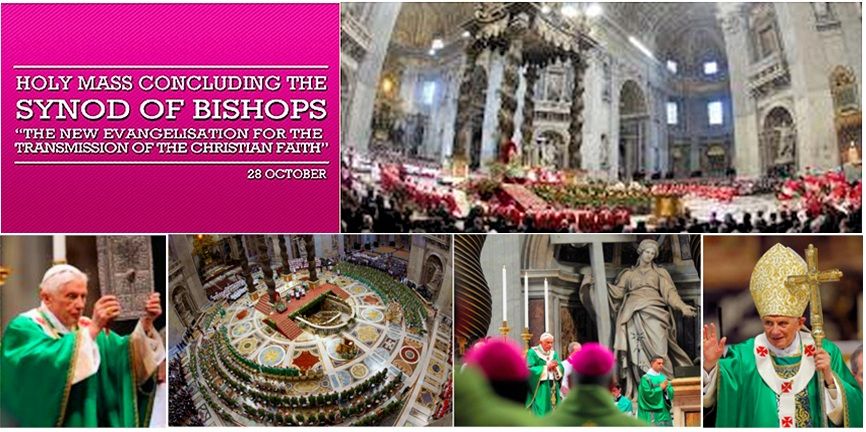 Mendicants begging for
Mendicants begging for
a sense to human life
Translated from

Oct. 30, 2012
The blind Bartimaeus, a roadside beggar, wished to recover his sight and cried out to Jesus as he passed by. Benedict XVI had the audacity to compare his situation to that of so many men in our time who have lost the light of faith and consequently are unable to find their place in the world.
Andre Malraux said, "There is no ideal for which we can sacrifice ourselves, because we know the lies behind everything, we who do not know what truth is".
The Pope deploys this interesting binomial of faith and light, well aware that our dominant culture situates faith itself 'on the dark side' of things, in the realm of subjectivity which allows no contradiction nor verification that can be rationally shared.
The Western world, which had been originally shaped by faith, has become full of Bartimaeuses, and for this, some responsibility falls on us Christians ourselves.
But it is precisely from our experience of this darkness, of a void, that the nostalgia for a different vision emerges. As Benedict XVI underscored in his homily at the Mass opening the Year of Faith: "In the desert we rediscover the value of what is essential for living; thus in today’s world there are innumerable signs, often expressed implicitly or negatively, of the thirst for God, for the ultimate meaning of life".
For the Pope, it was also an important fact that Bartimaeus was a beggar, not using the word in its usual pejorative term, but in its Biblical sense: The beggar expects everything from the Other, he knows he is in extreme need of everything, and he cries out the pain in his heart without worrying about his image or possible ridicule.
"Beggars for the meaning of existence" is how Benedict XVI described so many men and women of our time, who are often unaware of being so. But at least they are seeking a sense to life, which shows that the human heart is living and open, though wounded in a way that cannot be healed by the culture of consumption or assorted ideologies.
We Christians are also mendicants for that which alone can quench the thirst of the human heart, even if we have already met him. That is why we can understand those who are still groping in their search, sometimes even slugging it out among themselves.
While the Synodal Assembly was taking place, something significant happened at the Universidad Complutense of Madrid which is not the stuff of headlines. A day of brilliant debate about the value of religion in the public space, a gesture of dialog and awareness fully appropriate in the university environment.
But some students bitterly impugned the validity of such a gesture, publicly expressing their antagonism towards the public presence of Christianity, addressing their vitriol at a lady professor whose church membership was no secret.
She did not elude their challenge, nor did she resort only to a dialectical response. Prompted by the verbal violence of her students in whom she discovered more than just a simple hostility to faith, she addressed them with an open heart. She sensed their seeking.
She spoke to them about encountering a different side of humanity, of how faith had helped her change her own relationship with her husband, of the mysterious charity that makes some of her friends personally bring food to families who cannot eke out their means until their next wages, of a man with a chronic ailment who found awakening and happiness in regaining his faith.
She showed them how her profession was more than just a function for her to fulfill, but that her ability to teach others was a sign of a greater intelligence, and that they should have discerned this.
She spent half an hour opening her heart to them. The silence was sepulchral. Protest gave way to strong commotion. Somehow, the eyes of her listeners had opened to a vision of humanity that did not seek to protect them from the blows of reality, but instead, demonstrated the spring that quenches the profound thirst that afflicts most men.
The great effort for New Evangelization which, as the Pope told the Synodal Fathers in his closing remarks to the assembly, is a dynamism that has always been present in various forms in the life of the Church, is a work of love and pain, not of wise stratagems.
The pain of Bartimaeus who cried out, the love of Jesus who asked him "What would you like me to do for you?". The pain of the Master who weeps at the sight of Jerusalem where he would meet his death, the love of the Samaritan woman who ran and called her neighbors to come and see the man from Galilee.
The Church has to learn - as it is always learning - to be present in new contexts that she neither chooses nor controls. This is not learned by organizing seminars or tabulating data from endless inquiries, but by the men of the Church loving their flock and suffering with them the circumstances that they mus live with.
And that is why the Church must use "new language attuned to the different world cultures, proposing the truth of Christ with an attitude of dialogue and friendship rooted in God who is Love".
Benedict XVI will now prepare a document that will summarize the work of the Synodal Assembly, "a document that comes from life and that must generate life". Even if she must navigate against strong contrary winds, the Church is above all propelled beyond perplexity and fear by the wind of the Holy Spirit.
Fr. Schall, too, offers a brief reflection on the Bartiameus homily:
The Pope, the blind man,
and the New Evangelization
by Fr. James V. Schall, S.J.

“The interpretation [of St. Augustine] that Bartimaeus was a man who had fallen from a condition of ‘great prosperity’ causes us to think. It invites us to reflect on the fact that our lives contain precious riches that we can lose, and I am not speaking of material riches here.”
— Pope Benedict XVI, Homily, October 28, 2012
The homilies of Pope Benedict XVI are always distinguished by the many levels at which he addresses us.
This Pope is a teacher; he is a scholar. He always tells us the context of what he is talking about. He speaks on the matter at hand, usually the text in the Mass he is celebrating. For the Mass at the end of the Synod, which is the Mass of the Thirtieth Sunday of the year, the text of the Gospel concerns one Bartimaeus, a blind man whom Christ encounters outside of Jericho.
In the structure of Mark’s Gospel, Benedict tells us, this curing of Bartimaeus’ blindness occurs at an important point. “The whole of Mark’s Gospel is a journey of faith, which develops gradually under Jesus tutelage.” In one sentence, we are given the whole scope of this particular Gospel.
The first “actors” on this journey are the apostles themselves. Evidently, they are being taught something that they may not be aware of. The journey or pilgrimage is to the Holy City. Jesus is now going there. He knows what is in store for Him. He is with some disciples and many people.
These people will be the ones who later “recognize” Him as the Messiah as He rides into the Holy City when He arrives there. Bartimaeus is begging by the side of the road. He is blind. The healing of Bartimaeus is the “last miraculous healing before Jesus enters His passion.”
Here Benedict tells us it is not an “accident” that the man is blind. “We know from other texts that the state of blindness has great significance in the Gospels. It represents man who needs God’s light, the light of faith, if he is to know reality truly and to walk the path of life.”
God is light. Darkness is to lack light, not to know, to disbelieve. That is a remarkable sentence. If we are to know “reality,” if we are to know what is, we need, in addition to our minds (but not apart from them), faith, trust in the Word, in the Light. It looks like the man who does not have faith does not know reality. We will remain blind without the light of faith, even if we see.
[Modificato da TERESA BENEDETTA 31/10/2012 13:06] |
| |
 30/10/2012 21:05 30/10/2012 21:05 |
|
| | | OFFLINE | | Post: 397
Post: 32 | Registrato il: 17/05/2006
Registrato il: 02/05/2009 | Utente Comunità | Utente Junior | |
|
Very relieved to see that you are coping rather well with Hurricane Sandy, Teresa. Thanks heaven! I got very worried what with all the coverage on CNN and other channels. Trust you to calmly continue with your Benedict XVI and Church reporting in the midst of a monstrous storm.
Thank you once again for all your translations from various global sources which are not normally found on most English language blogs or forums.
Keep well! ![[SM=j7798]](https://im0.freeforumzone.it/up/0/98/2971038.jpg)
 Hi. Crotchet! Thanks for the concern. I live in what is virtually the center of Manhattan island, on a fourth-floor apartment, so the superstorm has hardly affected me, thank God, except that I can go nowhere because there has been no public transport in Manhattan since Sunday night. Inside the house, I can neither feel the winds nor the heavy rains, the trees on my street seem to be well-anchored below the sidewalks, and the buildings are not skyscrapers so there is no wind tunnel effect to exaggerate the gusts of wind and uproot the trees. It also means that so far, there have been no power lines, telephone lines or cable lines knocked out in my area. But my TV screen shows me the ordeal for people living along coastal areas and other vulnerable areas all along the easteern seaboard, and I can only pray the Lord gives them spiritual strength and enables material means to get to them so they can rebuild their devastated homes and lives ASAP.
Hi. Crotchet! Thanks for the concern. I live in what is virtually the center of Manhattan island, on a fourth-floor apartment, so the superstorm has hardly affected me, thank God, except that I can go nowhere because there has been no public transport in Manhattan since Sunday night. Inside the house, I can neither feel the winds nor the heavy rains, the trees on my street seem to be well-anchored below the sidewalks, and the buildings are not skyscrapers so there is no wind tunnel effect to exaggerate the gusts of wind and uproot the trees. It also means that so far, there have been no power lines, telephone lines or cable lines knocked out in my area. But my TV screen shows me the ordeal for people living along coastal areas and other vulnerable areas all along the easteern seaboard, and I can only pray the Lord gives them spiritual strength and enables material means to get to them so they can rebuild their devastated homes and lives ASAP.
I hope all is well with you. Is summer coming on in Stellenbosch? I have fond memories of your charming historic city in the magnificent setting of the Western Cape. I'd rather be in South Africa now than in Manhattan!
TERESA
[Modificato da TERESA BENEDETTA 30/10/2012 22:10] |
| |
 30/10/2012 21:26 30/10/2012 21:26 |
|
| | | OFFLINE | | Post: 25.728
Post: 8.223 | Registrato il: 28/08/2005
Registrato il: 20/01/2009 | Administratore | Utente Master | |
|

 The Shroud of Turin:
The Shroud of Turin:
Mirror of the Gospel
by Giacomo Galeazzi
Translated from the Italian service of

Oct. 29, 2012
From the Holy Shroud to Christ of the Gospels. The mystery of the Shroud of Turin came to the eternal city this weekend, when the Archdiocese of Turin and the Pontifical University Regina Apostolorum organized a day of study and prayer at the Roman Church of Santa Croce in Gerusalemme.
Paul Claudel said of the Shroud of Turin: "It is a realistic document, naturally made. Before this image, one is conquered by its nobility, its majesty, its sorrow - it is truly the face of a dead man who has resurrected".
The conference entitled "La Sindone specchio del Vangelo, una proposta per l’Anno della Fede" [The Shroud as a mirror of the Gospel: A proposal for the Year of Faith] gathered together some of the leading international experts on the Shroud, such as Giuseppe Ghiberti and Roberto Gottardo, president and vice-president, respectively, of the Turin diocesan commission for the Shroud; Enrico Feroci, director of Caritas Roma; Gian Maria Zaccone, scientific director of the Shroud Museum of Turin; Bruno Barberis, director of the International Sindonology Center of Turin; the Franciscan Gianfranco Berbenni, professor of Church history; Rafael Pascual, Legionnaire of Christ (LC) and director of the Science and Faith Institute of the Regina Apostolorum University; and Fr. Hector Guerra, also an LC and director of Istituto Sacerdos.
Meanwhile, the complex and continuing work of restoring the Shroud [which suffered charring and other superficial damage during a fire in 19...) has since made clearer the image of the human body impressed like a photographic negative on the linen cloth, about which numerous hypotheses have been formulated in the course of centuries none of which has so far gained a full consensus in the scientific community and among religious organizations.
The first irrefutable historical datum about the Shroud comes from 1353, when it was deposited by the Crusader knight Geoffroy de Charney in the Church of Lirey, France. Historian Silverio Novelli says that the Shroud remained in Lirey until 1453 when it was handed over to the Italian royal House of Savoy.
The Shroud is a piece of undyed fine-quality linen measuring 441 cm long by 113 cm wide (roughly 14.5 ft by 3.7 ft), folded longitudinally in half. On one half side is the barely visible outline of the full frontal image, and on the other is the full dorsal image, of a man about 5 feet 11 inches tall, who appears lean, and has long hair and a beard.
The images representing his arms and legs contain numerous signs of lacerations and bruises, with reddish-brown bloodlike spots (analysis limited so far to stains from the facial area show that they were human blood spots transferred to the cloth by contact) found most intensely on the face and in the back of the head, on the rib cage, at the wrists and on the feet.
The image of the body that must have been wrapped in the Shroud distinctly shows the signs of someone who died a violent death, established by medico-legal studies to be directly due to asphyxiation and circulatory problems resulting from particularly bloody maltreatment, of which the Shroud indirectly attests through the impressions on the cloth that are consistent with the historically documented practices of flagellation and crucifixion in the time of Jesus.
Scientific studies carried out on the Shroud, starting in 1898, on the basis of the photographs taken by lawyer Secondo Pia, have resulted over the following decades in a very complex case which have not so far allowed precise dating or geographical provenance for the cloth itself, which therefore makes it impossible to declare definitively that it was the funerary shroud that had wrapped the body of Jesus before he resurrected.
The first scientific committee to study the Shroud was established in 1966, and was followed in 1978 by new studies, and most notably, in 1978, when fragments of the Shroud were subjected to carbon-dating studies by three different laboratories (in Zurich, Oxford and Tucson) with controversial results. [Carbon-dating is an archaeological technique developed to determine the approximate age of any carbon-containing material by determining the half-life of the carbon radio-isotope C-14 that remains in the material.]
Carbon-dating dated the Shroud fragments tested to some time between 1260 and 1390, reinforcing a popular hypothesis that the Shroud is a medieval fraud.
However, recent studies have shown that pollen from the Shroud would appear to limit the cloth's origin from the area between Jerusalem and Hebron [the pollen could only have come from certain plants growing in that area at the time of Jesus], it would be consistent with the Gospel accounts of the Lord's Passion and death.
The carbon-dating results have been questioned by many scientists (as well as the faith community) on two grounds: first, that carbon dating is a limited and imprecise technique; and second, that the fragments subjected to this test were contaminated by stuff from a later date. [The more likely explanation is that the fragments came from material that had been used to repair damage to the edges of the Shroud, especially if, for obvious reasons, the fragments sent for study were snipped out from the edges and not from within the Shroud.]
|
| |
 31/10/2012 03:31 31/10/2012 03:31 |
|
| | | OFFLINE | | Post: 25.729
Post: 8.224 | Registrato il: 28/08/2005
Registrato il: 20/01/2009 | Administratore | Utente Master | |
|
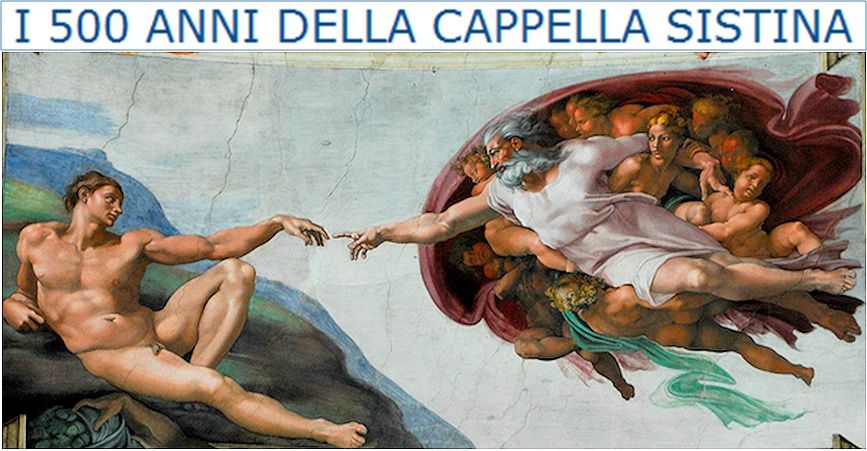
 Benedict XVI to celebrate Vespers
Benedict XVI to celebrate Vespers
at the Sistine Chapel to mark 500 years
since Michelangelo's ceiling frescoes
were inaugurated by Julius II
Just as Pope Julius II did on October 31, 1512, Pope Benedict XVI will preside at the celebration of Vespers at the Sistine Chapel today to mark the day when his predecessor inaugurated the vaulted ceiling that had been painted with frescoes by Michelangelo in 1508-1512.
Michelangelo in the Sistine Chapel:
Five centuries of blinding light
by Antonio Paolucci
Director of the Vatican Museums
Translated from the 10/31/12 issue of

Every day, at least 10,000 persons - and up to 20,000 during the peak tourist season - visit the Sistine Chapel. People of every origin, language and culture. Of every religion or no religion at all.
The Sistine Chapel is the fatal attracation, the object of the desire, the irrenunciable goal of museumgoers, the migrants of what has come to be called cultural tourism.
But the Sistine Chapel, although it is part of the standard tour of the Vatican Museums, is not a museum. It is a religious space, a cosnecrated chapel. More than that, it is the true and proper emblematic site of the Roman Catholic Church.
Here, great liturgies have been celebrated, and here, cardinals gathered in conclave have elected Popes for more than five centuries. At the same time, the Sistine is also the figurative and artistic synthesis of Catholic theology.
The history of the world - from the Creation to the Last Judgment - is represented in the Chapel, along with the destiny of mankind redeemed by Christ. The Sistine tells the story of salvation for each and everyone, even as it is an affirmation of the primacy of the Bishop of Rome
It illustrates the story of a Church which has absorbed, transformed and adopted the legacy of the Old Testament. It is the ark of the new and definitive covenant that God has established with the Christian people.
It was not accidental that the architext Baccio Pontelli, who worked on the chapel from 1477-1481, to modify and elevate the pre-existing structure, wished to give what would be Pope's Cappella Magna (main chapel), the measurements of the Temple of Jerusalem as it is described in the Bible.
Whoever enters the Sistine Chapel, in fact, enters an immense theologico-cultural charade that is difficult to comprehend at first glance. There are images (like the Creation of Man, and Original Sin) which will evoke in the vistor's memory - provided he comes from a country with a Christian culture - fragments of the Bible stories he learned as a child.
There are other images - the Prophets, the Sybils, some episodes of the Old Testament - that the ordinary visitor may not know at all. Because who, even among visitors who are practising Catholics, would know anything about the Punishment of Aman, or the raising of the serpent of bronze, or who would be able to explain, with a minimum of correctness, who was the Sybil Cumana or the Prophet Jonah?
And then, there is Michelangelo with his great celebrity who - like a too-strong light who blinds everyone around him - also occupies the attention of the visitor, which makes it more difficult for him to have a systematic grasp of the system of symbols with which Michelangelo worked.
There are various ways entering into the 'Sistine system', and all are necessary.
First of all, there is iconographic understanding in order to decipher the symbols. One must look, look again, and then look once more, at the scenes illustrated in the frescoes to try and locate them in time, in history, in the doctrine that has given them meaning.
Then one must grasp the stylistic message, which is a difficult task for those who do not have the right historico-critical knowledge to do so.
On that October 31, 1512, when Pope Julius II celebrated Vespers to inaugurate Michelangelo's frescoed vault - which he completed after immense effort that lasted four years (1508-1512) - the Pope could not have imagined that the frescoes covering more than a thousand square meters would unleash onto the history of art a violent torrent bearing not just happiness but also devastation, as Woelfflin wrote in 1899.
In fact, after Michelangelo's monumental work on the vaulted ceiling of the Sistine, the history of art in Italy and in Europe would change radically. Nothing could be as before. The vault started that era in art that the manuals call Mannerism.
The vault, wrote Giorgio Vasari, would become the lamp destined to light the history of art styles for the next generations of artists.
To understand the radicality of the revolution achieved by Michelangelo, one must compare his frescoes with those that Julius II's uncle, Pope Sixtus IV (for whom the chapel is named), had commissioned for the walls of the chapel from the best artists in his time - Ghirlandaio, Botticelli, Perugino, Luca Signorelli.
The visitor who first feasts his eyes on the frescoes on the vault and then at the frescoes on the wall will have the impression that Michelangelo and the other artists were separated in time by 300 years and not by 30 years.
This comparison will suffice to make even the first-time visitor who can only spare an hour in the Sistine Chapel understand the depth and extent of the mutation that Michelangelo Buonarroti had wrought in the art of painting - a revolution that was philosophical, spiritual and religious and not just stylistic.
In addition - to the knowledge of iconography and the competencies of the art historian, one must also have the sensibility of an art conservator - there is also an approach to the Sistine that concerns how the 'usage' of our day weighs on this supreme document of human civilization.
It is an approach that I know ever well because it concerns my responsibility as the director of the Vatican Museums. Five million visitors come into the Sistine Chapel every year - at least 10,000 a day, and double that during the peak of the tourist season. That represents a very difficult problem.
The human presence, with the dust on his clothes, with the humidity that bodies have, with the carbon dioxide exhaled during breathing, all this are not just inconvenient for the visitors who are sometimes packed into the chapel, but are also factors that could damage the paintings in the long run.
We could limit access at any one given time, setting a maximum number. And we shall do so if the touristic pressure should incrase beyond the limits of reasonable tolerability and if we fail to confront the problem effectively.
But I believe that in the medium term, capping the number of visitors at any one time will not be necessary. Meanwhile - and this is the goal that has occupied our efforts in recent months - we must put to use all the most advanced technological means that are capable of filtering out dust and other pollutants, that will allow fast and efficient air flow and exchange, along with temperature and humidity controls.
This is being carried out, using the most sophisticated and radically innovative technology, by the multinational Carrier which is a world leader in the climatization industry. I am confident that within a year, the new installation will be functioning.
Giovanni Urbani, a great contemporary architect, says that it is not for our time to be given a new Michelangelo, but we are given progress in technology which will allow us, if we use it correctly, to conserve the Michelangelo works that history has passed on to us in good condition for as long as possible.
The restoration of Michelangelo's frescoes:
When the colors of genius
were recovered for posterity
Translated from the 10/31/12 issue of

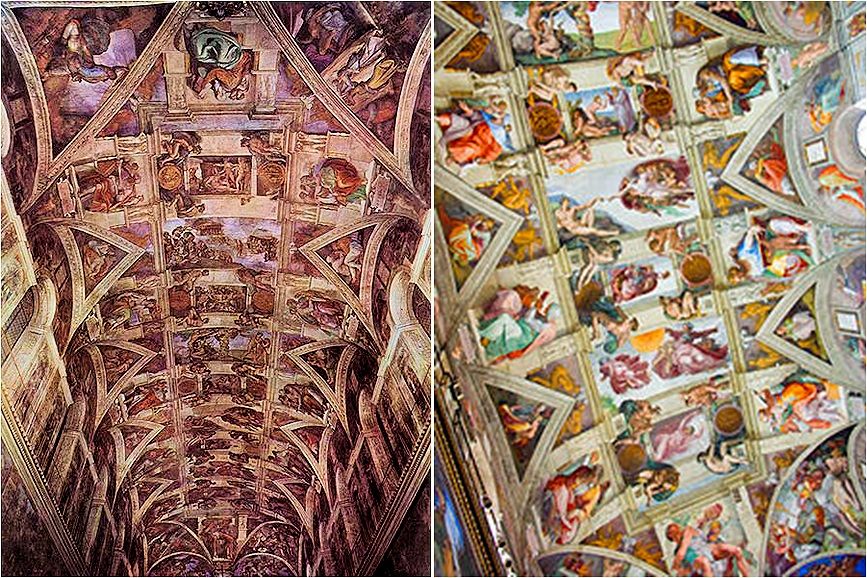 The dramatic difference between the Sistine vault frescoes before and after the massive clean-up restoration; below, a composite of the panel on Original Sin, with the left side before the clean-up, and the right, afterwards.
The dramatic difference between the Sistine vault frescoes before and after the massive clean-up restoration; below, a composite of the panel on Original Sin, with the left side before the clean-up, and the right, afterwards.
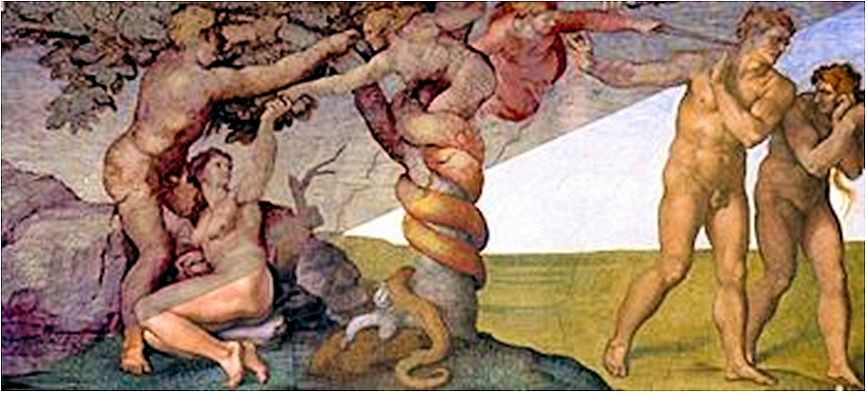
On March 25, 1990, Pope John Paul II inaugurated an exhibit entitled "Michelangelo and the Sistine Chapel: The technique, the restoration, the myth", which was organized in close collaboration by the Vatican Museums and the Vatican Apostolic Library.
The following day, an international conference on the same topic opened at the Palazzo della Cancelleria.
Noth initiatives were born from the same need: to put at the disposition of the public all the information that had been gathered in order to allow a first complete analysis of the problems that had to be confronted and the results of the restoration.
The exhibit was primarily addressed to the wider public, the conference to the narrow circle of specialists, who were shown, among other things, the first tests of the 'clean-up' done on the Last Judgment, creating a kind of bridge between the problems of the past and those of the present, and an occasion to review the stages of the extraordinary operation that led to the recovery of the original colors of Michelangelo's masterpiece.
Between 1964 and 1974, under the supervision of Deodecio Redig de Campos who was also director of the Vatican Museums at the time, the cleaning of the panels illustrating the stories of Jesus and of Meses was undertaken using the best available means at the time.
That work had been preceded in 1935-1938 by consolidating the plasterwork on half of the vault and of the minor lunettes (half-moon shaped panels). Getting to the bridge over the entrance wall to the chapel, they had come almost to the lunettes painted by Michelangelo on the ancestors of Jesus.
Chief restorer Gianluigi Colalucci took the occasion to try cleaning out out a postage-stamp sixed area on the lunette representing Mathan and Eleazar. The attempt was then extended to the whole lunette.
What emerged, pefectly conserved under a thick layer of dust, some and gum, were the original colors as Michelangelo painted them - "those colors", said Carlo Pietrangeliu, then the director general of Pontifical monuments, galleries and museums, "that we had been accustomed to see in the first generation of Florentine Mannerists and that Michelangelo himself had used in his tondo (round painting) of the Holy Family".
"It became necessary at this point," he continues, "to reflect on what we could do - we were faced with the enormous responsibility of carrying out a daring operation, whose results would eventually prove extremely important to the history of art. One consideration impelled us to proceed without delay - in many places of the painted surfaces, the images appeared 'torn' because of the variations in humidity and temperature over time, by layers of glue that had been slapped on the frescoes over the centuries to improve the visibility of the images or to cover up the fading caused by infiltration of rainwater into the ceiling. The clean-up was therefore urgent not just to recover the original colors, but in order to assure the very conservation of the frescoes."
To carry out the restoration of the ceiling frescoes, an appropriate mobile scaffold was built of light metal suported by the short beams that had supported Michelangelo's own scaffold and that were revealed after cleaning the lunettes along the walls of the chapel.
Between June 1980 and October 1984 the first stage of restoration, the work upon Michelangelo's lunettes, was achieved. The focus of the work then transferred to the ceiling, which was completed in December 1989 and from there to the Last Judgment. The restoration was unveiled by Pope John Paul II on 8 April 1994. The final stage was the restoration of the wall frescoes, approved in 1994 and unveiled on 11 December 1999.
[Modificato da TERESA BENEDETTA 31/10/2012 03:47] |
| |
 31/10/2012 14:10 31/10/2012 14:10 |
|
| | | OFFLINE | | Post: 25.730
Post: 8.225 | Registrato il: 28/08/2005
Registrato il: 20/01/2009 | Administratore | Utente Master | |
|
 Wednesday, Oct. 31, 30th Week in Ordinary Time
Wednesday, Oct. 31, 30th Week in Ordinary Time
 Left, a German stamp commemorating the 100th anniversary of the saint's death in 1994.
ST. WOLFGANG OF REGENSBURG (Germany, ca 224-294), Teacher, Benedictine Monk, Bishop
Left, a German stamp commemorating the 100th anniversary of the saint's death in 1994.
ST. WOLFGANG OF REGENSBURG (Germany, ca 224-294), Teacher, Benedictine Monk, Bishop
Born in Germany but educated by Benedictine monks in Reichenau, Switzerland, he became friends with a nobleman who would become Archbishop of Trier. Wolfgang taught at the cathedral school of Trier and helped his friend to reform the clergy. When the Archbishop died, he decided to become a Benedictine himself and became director of the monastery school in Einsiedeln. Later, he was sent as a missionary to Hungary. Then, Emperor Otto II appointed him Bishop of Regensburg, where he immediately initiated clergy reform, keeping to his austere life as a monk. He became tutor to the future emperor and saint, Henry II. Wolfgang was noted for his preaching and teaching, his charity and his care for lay people in the diocese. In the final years of his life, he retired to a hermitage in upper Austria, where he died in 994. He was canonized in 1052. Along with St. Ulrich (who ordained him) and St. Conrad of Constanz, Wolfgang is one of the three great German saints of the 10th century,
Readings for today's Mass:
www.usccb.org/bible/books-of-the-bible/
AT THE VATICAN TODAY
General Audience - The Holy Father continued his new catechetical cycle on the articles of Catholic faith
and offered his prayers for the victims of the hurricane which struck the East coast of the USA this week.
[Modificato da TERESA BENEDETTA 31/10/2012 14:23] |
| |
 31/10/2012 14:11 31/10/2012 14:11 |
|
| | | OFFLINE | | Post: 25.731
Post: 8.226 | Registrato il: 28/08/2005
Registrato il: 20/01/2009 | Administratore | Utente Master | |
|
 GENERAL AUDIENCE TODAY
GENERAL AUDIENCE TODAY
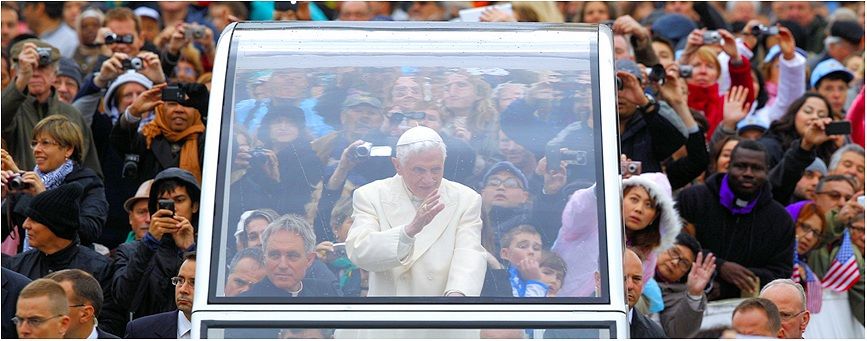
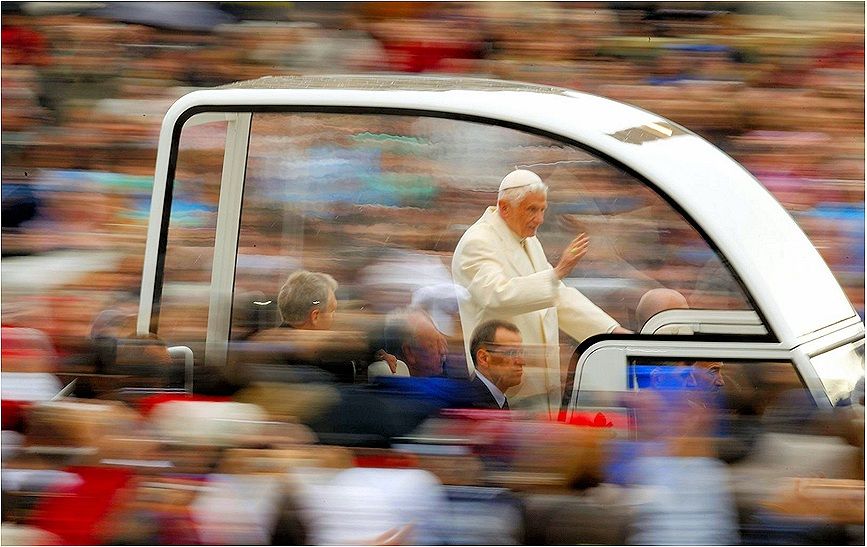
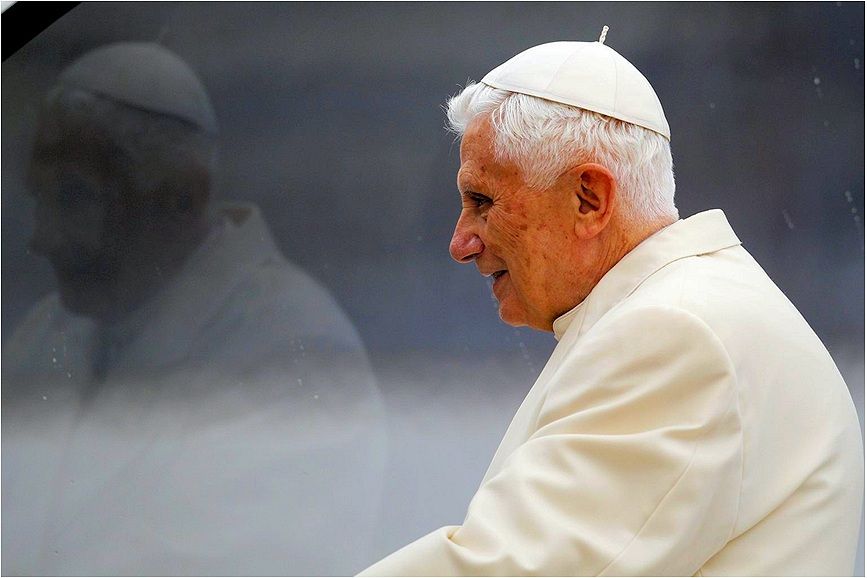 'Faith is given through the Church,
'Faith is given through the Church,
nourished and transmitted through her'
Abridged from

October 31, 2012
“In a world where individualism seems to regulate relationships between people, rendering them increasingly fragile, faith calls us to be people of God, to be Church, and bearers of God’s love and communion for all mankind", said Pope Benedict XVI Wednesday as he continued his general audience catechesis on the ‘Act of Faith’, more familiarly known as the ‘Creed’.
Despite foreboding skies and sharp temperatures, the audience was held in St Peter’s square. In off the cuff comments to the thousands who withstood the drizzle huddled under umbrellas to hear the Pope’s words, Benedict XVI noted ‘it could be worse’.
Last week the Pope had spoken of how we have seen that faith is something intensely personal: a gift of God which transforms and enriches our life. But, he asked today: “If faith is of a purely personal, individual character? Does it only affect me personally? Do I live my faith alone?”...
Here is how the Pope synthesized the catechesis in English:
In our series of catecheses for the Year of Faith, we have seen that faith is something intensely personal: a gift of God which transforms and enriches our life.
At the same time, the gift of faith is given in and through the community of the Church. In Baptism I receive and appropriate the faith of the Church; my personal faith finds expression in the recitation of the Creed and in the communal celebration of the sacraments.
The new life I live in Christ through the gift of his Spirit is received and nourished within the Church’s communion. In this sense, the Church is our Mother. As Saint Cyprian says, "No one can have God as Father who does not have the Church as Mother". Dwelling in the Church’s living Tradition, may we mature in the faith we have received and, by putting it into practice, become beacons of Christ’s light and peace in our world.
The Holy Father then added a special thought for the victims of the superstorm Sandy which hit the eastern United States this week:
Conscious of the devastation caused by the hurricane which recently struck the East Coast of the United States of America, I offer my prayers for the victims and express my solidarity with all those engaged in the work of rebuilding

Here is a translation of the full catechesis:
Dear brothers and sisters,
Let us continue our journey of meditation on the Catholic faith. Last week, I showed that faith is a gift, because it is God who takes the initiative to come towards us - thus, faith is a response by which we welcome him as the firm foundation of our life.
It is a gift that transforms existence, because it makes us enter the vision of Christ who works in us and opens us up to love of God and of our fellowmen.
Today, I wish to take another step in our reflection, starting once again from some questions: Is the character of faith only personal and individual? Does it interest my person only? Do I live my faith by myself?
Of course, the act of faith is an eminently personal act, which comes from my deepest intimacy and which marks a change of direction, a personal conversion - and it is my existence that has a turning point, a new orientation.
In the liturgy of Baptism, at the moment of the promises, the celebrant asks that the Catholic faith be professed and formulates three questions:
- Do you believe in God the Father almighty?
- Do you believe in Jesus Christ his only Son?
- Do you believe in the Holy Spirit?
In early Christianity, these questions were directed personally at he who was to receive Baptism before he was immersed three times in water. Even today, the answer to the questions is in the singular: 'Credo' - I believe.
But my believing is not the result of my solitary reflection, it is not the product of my thought, but it is the fruit of a relationship, of a dialog, in which there is a listening, a receiving, and a response. It is communicating with Jesus that makes me emerge from the 'I' enclosed in myself in order to open up to the love of God the Father.
It is like a rebirth in which I find myself united not just to Jesus but also to all those who have walked and are walking along the same path. And this new birth which begins with Baptism continues throughout the course of my existence.
I cannot construct my personal faith in a private dialog with Jesus, because faith has been given to me by God through the community of believers which is the Church, which thus places me among the multitude of believers in a communion that is not merely sociological, but rooted in the eternal love of God, who in himself is the communion of the Father, the Son and the Holy Spirit - God is trinitarian Love.
Our faith is truly personal only when it is also communitarian. It can be my faith only if it lives and moves within the 'we' of the Church - only when it is our faith, the common faith of the one Church.
On Sundays, at Holy Mass, when we recite the Credo - I believe - we express ourselves in the first person, but we are confessing communally the one faith of the Church. That 'credo' that we pronounce individually joins an immense chorus in time and space, in which everyone contributes, so to speak, to a concordant polyphony of faith.
The Catechism of the Catholic Church summarizes this clearly this way: "'To believe' is an ecclesial act. The faith of the Church precedes, generates, sustains and nourishes our faith. The Church is the Mother of all believers. 'No one can say that God is his Father unless the Church is his Mother' (St. Cyprian)" (No. 181).
Therefore, faith is born in the Church, it leads to the Church, and it lives in her. This is very important to remember.
At the start of the Christian adventure, when the Holy Spirit descended powerfully on the disciples on the day of Pentecost - as the Acts of the Apostles recounts (cfr 2,1-13) - the nascent Church received the power to carry out the mission entrusted to her by the risen Lord: to spread the Gospel to every corner of the earth, the Good News about the Kingdom of God, and thus lead every man to an encounter with Christ, to the faith that saves.
The Apostles overcame all fear in proclaiming what they had heard, seen and experienced personally of and with Jesus. Through the power of the Holy Spirit, they began to speak in new languages, openly proclaiming the mystery to which they had been witnesses.
In the Acts of the Apostles, we are given the great discourse that Peter pronounced on that day of Pentecost. He took off from a passage from the prophet Joel (3,1-5), referring it to Jesus, and proclaiming the central nucleus of the Christian faith: "He who had been commended to you by God with mighty deeds, wonders and signs... you killed, using lawless men to crucify him, but God raised him up from the throes of death...(and) God has made him both Lord and Messiah, this Jesus whom you crucified" (cfr Acts 2,17-24). With him, he continued, we enter into the definitive salvation announced by the prophets and whoever invokes his name will be saved.
Hearing these words of Peter, many felt themselves personally interpellated, they repented of their sins and asked to be baptized, receiving the gift of the Holy Spirit (cfr Acts 2, 37-41).
Thus the journey of the Church began, a community that carries this message through time and space, a community that is the People of God based on the new covenant sealed by the blood of Christ, and whose members do not belong to any specific social or ethnic group, but are men and women coming from every nation and culture.
It is a 'catholic' people, who speak new languages, universally open and welcoming to everyone, beyond any frontier, and breaking down all barriers. St. Paul says: "Here there is not Greek and Jew, circumcision and uncircumcision, barbarian, Scythian, slave, free; but Christ is all and in all" (Col 3,11).
Thus, the Church, from the very beginning, is the place of faith, the place for transmitting the faith, the place in which, through Baptism, we are immersed in the Paschal Mystery of the death and resurrection of Christ, which liberates us from the prison of sin, gives us the freedom of children, and introduces us to communion with the Trinitarian God.
At the same time, we are immersed in communion with our brothers and sisters in the faith, with the entire Body of Christ, we who have been drawn out of our isolation.
The Second Vatican Ecumenical Council reminds us: "God does not make men holy and save them merely as individuals, without bond or link between one another. Rather has it pleased Him to bring men together as one people, a people which acknowledges Him in truth and serves Him in holiness" (Lumen gentium, 9).
Recalling once more the liturgy of Baptism, we note that, at the end of the promises during which we renounce evil and we repeat 'Credo' - I believe - to the truths of the faith, the celebrant declares: "This is our faith, this is the faith of the Church, and we glory in professing it in Christ Jesus our Lord".
Faith is a theological virtue, given by God, but transmitted by the Church throughout history. St. Paul, writing to the Corinthians, says he has communicated to them the Gospel which he, in his turn, had received (cfr 1 Cor 15,3).
There is an uninterrupted chain in the life of the Church - of announcing the Word of God, of celebrating the Sacraments, which has come down to us and which we call Tradition. It gives us the guarantee that what we believe is the original message of Christ as preached by the Apostles.
The nucleus of the primordial announcement is the event of the death and resurrection of the Lord, from which flows our entire patrimony of faith.
The Second Vatican Council says: "The apostolic preaching, which is expressed in a special way in the inspired books, was to be preserved by an unending succession of preachers until the end of time" (Dei verbum, 8). Thus, if Sacred Scripture contains the Word of God, the Tradition of the Church conserves and transmits it faithfully, so that man in every age can have access to its immense resources and enrich himself with her treasures of grace.
"And so the Church, in her teaching, life and worship, perpetuates and hands on to all generations all that she herself is, all that she believes" (ibidem).
Finally, I wish to underscore that it is in the ecclesial community that personal faith grows and matures. It is interesting to observe that in the New Testament, the word 'saints' designates Christians altogether, yet certainly not all had the qualities to be declared saints of the Church.
What then was meant by the use of this term? The fact that those who had faith in the risen Christ and lived it were called upon to become a point of reference for all the rest, placing them in contact with the Person and the Message of Jesus, who reveals the face of the living God.
This is true even for us: A Christian who allows himself to be led and gradually formed by the faith of the Church, despite her weaknesses, her limitations and her problems, becomes like a window open to the light of the living God who receives this light and transmits it to the world.
Blessed John Paul II in the encyclical Redemptoris missio stated that "mission renews the Church, reinvigorates the faith and Christian identity, and gives new enthusiasm and new motivations. Faith is reinforced by giving it" (No. 2).
The widespread tendency today to relegate the faith to the sphere of the private therefore contradicts its very nature. We need the Church to confirm our faith and to experience the gifts of God: his Word, the Sacraments, the sustenance of grace and the witness of love.
Thus, our 'I' within the 'we' of the Church is able to perceive itself as being, at the same time, recipient and protagonist of an event which is beyond the 'I': the experience of communion with God, which lays the basis for communion among men.
In a world where individualism seems to regulate relationships among persons, making them ever more frail, faith calls us to be the People of God, to be Church, bearers of love and the communion of God for all of mankind" (Gaudium et spes, 1). Thank you for your attention.
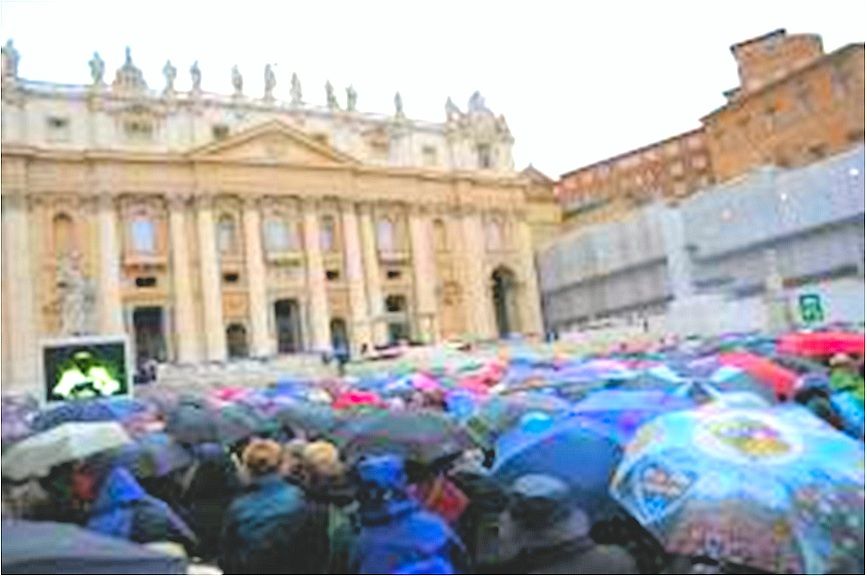
[Modificato da TERESA BENEDETTA 01/11/2012 06:25] |
| |
 01/11/2012 07:31 01/11/2012 07:31 |
|
| | | OFFLINE | | Post: 25.732
Post: 8.227 | Registrato il: 28/08/2005
Registrato il: 20/01/2009 | Administratore | Utente Master | |
|
 First Vespers
First Vespers
Solemnity of All Saints
October 31, 2012
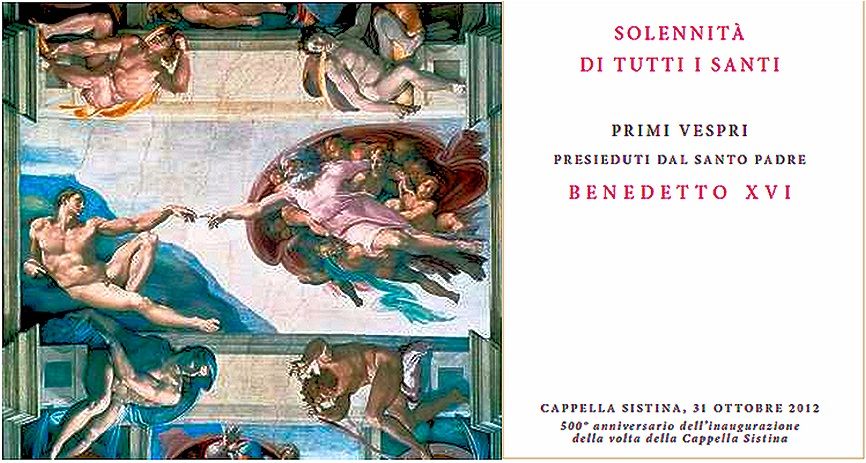 The Sistine Chapel:
The Sistine Chapel:
'A liturgical classroom'

October 31, 2012
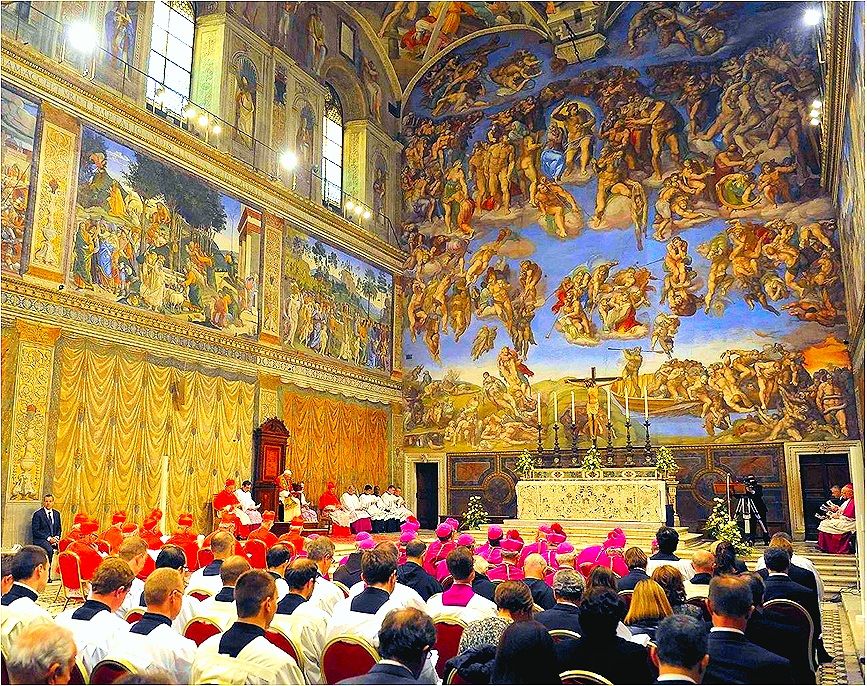 Above, Benedict XVI presides at Vespers in the Sistine Chapel; below, courtesy of AP, the Sistine Chapel on April 16, 2005, as it was being prepared for the Conclave that began two days later and would elect Cardinal Ratzinger Pope on April 19.
Above, Benedict XVI presides at Vespers in the Sistine Chapel; below, courtesy of AP, the Sistine Chapel on April 16, 2005, as it was being prepared for the Conclave that began two days later and would elect Cardinal Ratzinger Pope on April 19.
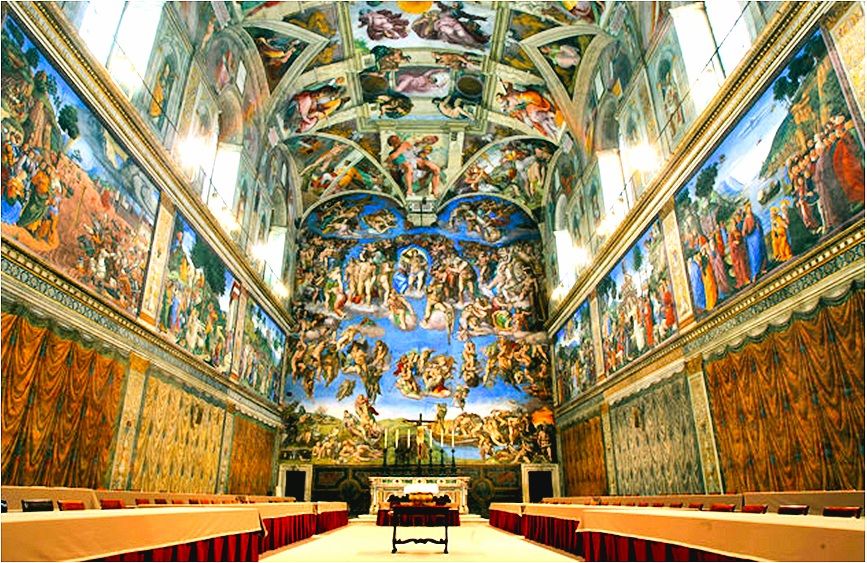
Pope Benedict XVI celebrated Vespers on Wednesday in the Sistine Chapel, 500 years after his predecessor Pope Julius II did the same thing to mark the completion of Michelangelo’s ceiling masterpiece. Charles Collins has this report:
Calling the Sistine Chapel a “liturgical classroom”, Pope Benedict said he was marking the anniversary of this “historical and artistic event” with a liturgical celebration because “the works of art which decorate it, especially the frescoes, find in the liturgy… their living environment. It is the context in which is expressed their beauty, their richness, and the significance of their meaning.”
“It is as if during the liturgical action, the entire symphony of figures comes alive, certainly in the spiritual sense, but also…in the aesthetic sense,” the Holy Father continued. “The Sistine Chapel, encompassed in prayer, is even more beautiful, more authentic; it reveals all of its treasures.”
The Pope spoke of what the reaction must have been like for those who saw the ceiling for the first time, after Michelangelo worked on painting the more than 1000 square meters for four years, from 1508 to 1512.
Quoting Giorgio Vasari, he said “This work has been, and truly is, the lamp of our art, which has given so much good and light to the art of painting, enough to illuminate the world.”
“But it is not only the light that comes from the clever use of rich color contrasts, or the movement that animates the masterpiece by Michelangelo,” the Pope continued.
“[It is] the idea that permeates the great work: it is the light of God that illuminates these frescoes and the entire Papal Chapel. That light, with its power, conquers the chaos and darkness to give life; in creation and in redemption. The Sistine Chapel tells the story of light, liberation, salvation; it speaks of God's relationship with humanity,” said the Pope.
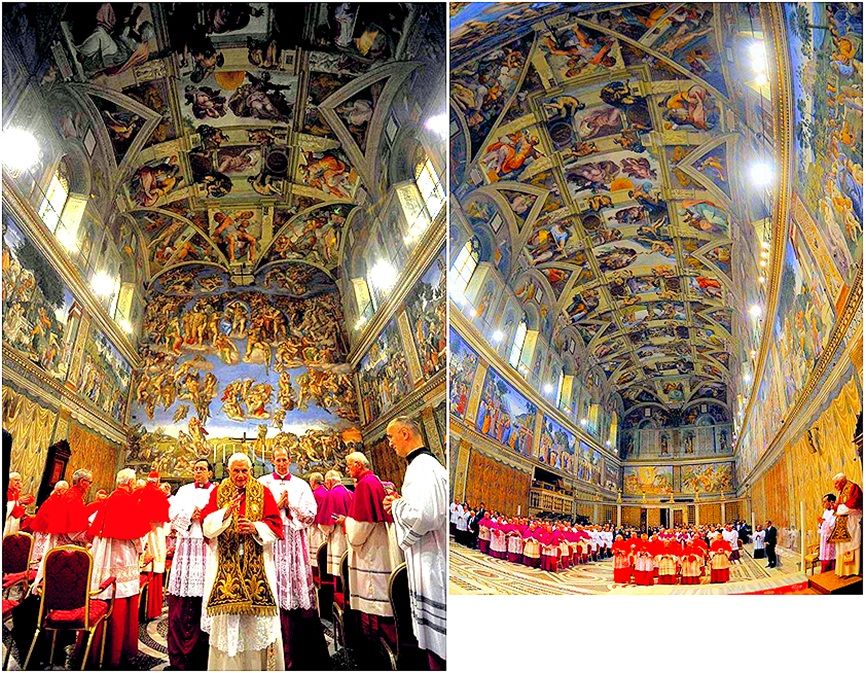
Here is a full translation of the Holy Father's homily:
Venerated Brothers,
Dear brothers and sisters:
In this liturgy of the First Vespers for the Solemnity of All Saints, we commemorate the act with which, 500 years ago today, Pope Julius II inaugurated the frescoes on the vault of this Sistine Chapel.
I thank Cardinal Bertello for the words he addressed to me and I extend cordial greetings to everyone present.
Why do we remember such a historical-artistic event in a liturgical celebration? First of all, because the Sistine is, by its nature, a liturgical hall - it is the Capella Magna (main chapel) of the Vatican Apostolic Palace.
Besides, the artistic works decorating it, especially the fresco cycles, find in liturgy what we may call their vital setting, the context in which they best express all of their beauty, all the richness and the pregnancy of their significance.
It is as of, during the liturgical act, all of this symphony of figures take life, certainly in a spiritual sense, but inseparably in the aesthetic sense as well, because perception of artistic form is typically human, and as such, involves the senses and the spirit.
In a few words, the Sistine Chapel, contemplated in prayer, is even more beautiful, more authentic - it reveals itself in all its richness. Here, everything lives, everything resonates in contact with the Word of God.
We heard a passage from the Letter to the Hebrews: "You have approached Mount Zion and the city of the living God, the heavenly Jerusalem, and countless angels in festal gathering..." (12,22-23) The Author is addressing Christians and explaining that for them, the promises of the Old Covenant have been realized: a feast of communion with God at the center - Jesus, the lamb who was immolated and resurrected (cfr vv-23-24).
All this dynamic of promise and fulfillment we find represented here in the frescoes on the walls, the work of the great Umbrian and Tuscan painters of the second half of the fourteenth century.
When the Biblical text continues to say that we have approached "the assembly of the firstborn enrolled in heaven, to God the judge of all, and to the spirits of the just (who have been) made perfect" (v. 23), we raise our eyes to Michelangelo's 'Last Judgment', where the blue background of heaven, repeated in the mantle of the Virgin Mary, gives the light of hope to the entire vision which is quite dramatic.
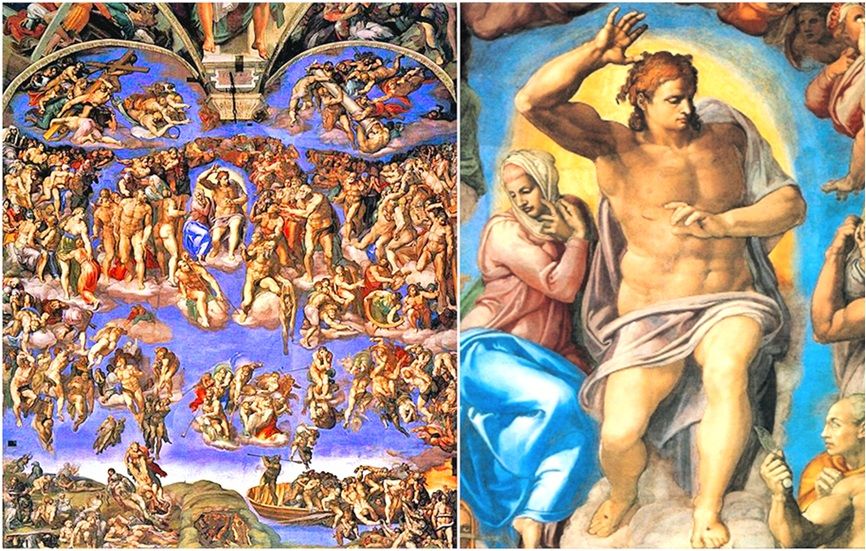
«Christe, redemptor omnium, / conserva tuos famulos, / beatæ semper Virginis / placatus sanctis precibus» (Christ, Redeemer of all things, / keep with thy servants, / the blessed and ever Virgin / appeased by the prayers of the saints) is chanted in the first stanza of the Latin hymn for these Vespers.
And that is precisely what we see: Christ the Redeemer at the center, crowned by his saints, and next to him is Mary, in an attitude of supplicant intercession, almost as if she wished to mitigate the tremendous final judgment.
But tonight our attention goes principally to the great frescoes of the vault that Michelangelo, commissioned by Julius II, realized ion four years, from 1508 to 1512. The great artist, already famous then for his masterpieces in sculpture, faced the undertaking of painting more than a thousand square meters of plastering, and we can imagine that the effect produced on those who saw the completed work must have been truly impressive.
These immense frescoes precipitated onto the history of Italian and European art - Woelfflin would say in 1899 in a beautiful metaphor that has become famous - something akin to "a violent mountain torrent bearing happiness and devastation at the same time - nothing was no longer as it was before".
Giorgio Vasari, in a famous passage from his Lives [of Famous Artists], wrote strikingly: "This work has been and is truly the lantern of our art, which has brought such joy and light to the art of painting, enough to illuminate the world".
Lantern, light, illuminate: three words by Vasari that would not have been far from the hears of those who were present at the celebration of Vespers on that October 31 in 1512. But it is not just the light that comes from the wise use of colors rich in contrasts, or from the movement that animates Michelangelo's masterpiece, but from the idea that runs through this great vault:
It is the light of God that illuminates these frescoes and the entire papal chapel. That light that with its power conquers chaos and darkness to give life - in creation and in redemption.
The Sistine Chapel narrates this story of light, of liberation, of salvation. It speaks of the relationship of God with mankind. In the genius-filled vault of Michelangelo, the eye is led to view the message of the Prophets, to whom are added that of the pagan Sibyls, in expectation of Christ, towards the beginning of everything: "In the beginning, God created heaven and earth" (Gen 1,1).
With unique expressive intensity, the great artist depicted God the Creator, his action, his power, to say with evidence that the world is not a product of obscurity, of chaos, of the absurd, but that it derives from an Intelligence, from a Freedom, from a supreme act of Love.
In that encounter between the finger of God and that of man, we perceive the contact between heaven and earth, In Adam, God entered into a new relation with his creation, man is in direct relationship with him, he is called up by him, he is the image and likeness of God.
Twenty years later, in the 'Last Judgment', Michelangelo would conclude the great arch of mankind's journey, urging us to look at the completion of the reality of the world and of man, to the definitive encounter with Christ, the Judge of the living and the dead.
Let us pray this evening in this Sistine Chapel, wrapped within the story of God's journey with man, admirably represented in the frescoes above and around us - an invitation to praisegiving, an invitation to raise up to God the creator, redeemer and judge of the living and the dead, with all the saints in heaven, the words of the canticle from the Apocalypse: "Amen, alleluia... Praise our God, all you his servants, you who fear him, great and small!...Alleluia!... Let us rejoice and exult, and render glory to him" (19,41.5.7a). Amen.
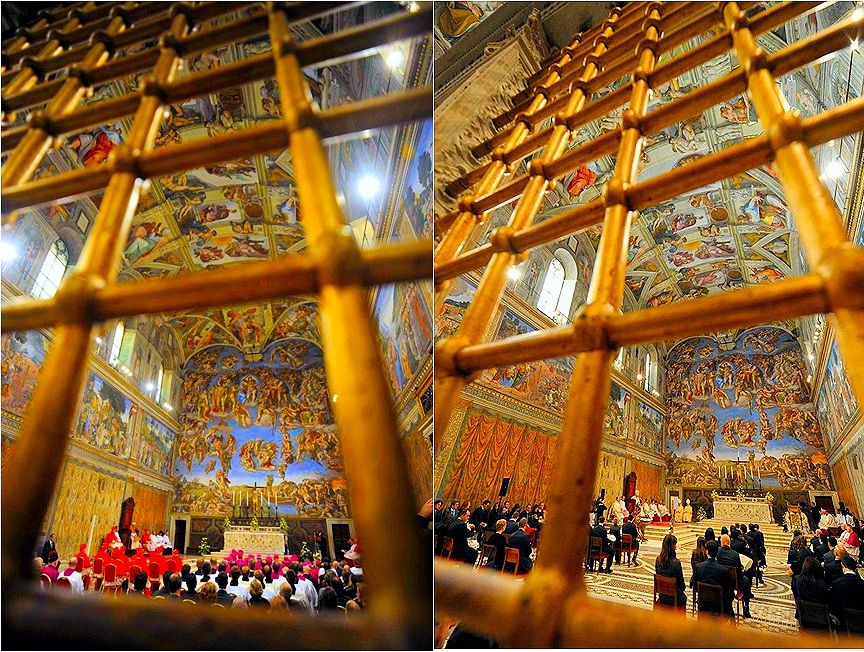 Benedict XVI celebrates
Benedict XVI celebrates
Michelangelo's 'symphony of figures'

VATICAN CITY, Oct. 31 (AP) -- Five centuries after Michelangelo's ceiling of frescoes was inaugurated in the Sistine Chapel, Pope Benedict XVI on Wednesday celebrated the "symphony of figures" contemplated during prayer.
Benedict marked the anniversary by saying Vespers beneath the frescoes, as his predecessor Julius II had half a millennium earlier.
The Pope said that contemplating the frescoes in the chapel of the Apostolic Palace renders them "more beautiful still, more authentic. They reveal all of their beauty."
"It is as if during the liturgy, all of this symphony of figures come to life, certainly in a spiritual sense, but inseparably also aesthetically," the Pope said.
At least 10,000 people visit the site each day, raising concerns about temperature, dust and humidity affecting the famed art. But a Vatican Museums official says there are no plans to try to limit tourists' access.
Museums Director Antonio Paolucci said in an article in the Vatican newspaper on Wednesday that sometimes as many as 20,000 people a day visit the chapel. But, he said, for the time being "the adoption of a maximum number (of visitors) will not be necessary."
[Modificato da TERESA BENEDETTA 01/11/2012 12:49] |
| |
 01/11/2012 13:11 01/11/2012 13:11 |
|
| | | OFFLINE | | Post: 25.733
Post: 8.228 | Registrato il: 28/08/2005
Registrato il: 20/01/2009 | Administratore | Utente Master | |
|
 Thursday, Nov. 1, 30th Week in Ordinary Time
Thursday, Nov. 1, 30th Week in Ordinary Time
SOLEMNITY OF ALL SAINTS
 Fra Angelico, Fiesole San Domenico altarpiece, 1423-24, National Gallery of London: From left, Virgin Mary with Apostles and Other Saints, Christ Glorious in the Court of Heaven, Forerunners of Christ. Fra Angelico, Fiesole San Domenico altarpiece, 1423-24, National Gallery of London: From left, Virgin Mary with Apostles and Other Saints, Christ Glorious in the Court of Heaven, Forerunners of Christ.
 From left, Raphael, Triumph of Religion, Fresco, 1508-1511, Vatican Apostolic Palace; Jan and Hubert Van Eyck, Ghent altarpiece, 1432; Vassily Kandinsky, All Saints, 1911.
From left, Raphael, Triumph of Religion, Fresco, 1508-1511, Vatican Apostolic Palace; Jan and Hubert Van Eyck, Ghent altarpiece, 1432; Vassily Kandinsky, All Saints, 1911.
The whole concept of All Saints Day is tied in with the concept of the Communion of Saints. This is the belief that all of God's people, on heaven, earth, and in the state of purification (called Purgatory in the West), are connected in a communion. In other words, Catholic and Orthodox Christians believe that the saints of God are just as alive as you and I, and are constantly interceding on our behalf. Our connection with the saints in heaven is one grounded in a tight-knit communion. The saints are not divine, nor omnipresent or omniscient. However, because of our common communion with and through Jesus Christ, our prayers are joined with the heavenly community of Christians.
The first reference to a general feast celebrating all saints occurs in St Ephrem the Syrian (d. AD 373). St. John Chrysostom (d. AD 407) assigned a day to the feast, the first Sunday after Pentecost, where in the Eastern Churches the feast is celebrated to this day. In the West, this date was probably originally used, and then the feast was moved to May 13th. The current observance (November 1) probably originates from the time of Pope Gregory III (d. AD 741), and was likely first observed in Germany.
Readings for today's Mass:
www.usccb.org/bible/readings/110112.cfm
AT THE VATICAN TODAY
Holiday Angelus - On the occasion of All Saints' Day, a major Catholic holiday, the Pope led
the noontime Angelus from his study window overlooking St. Peter's Square.
The Pope's prayer intentions
for November 2012
General Intention:
That bishops, priests, and all ministers of the Gospel may bear the courageous witness
of fidelity to the crucified and risen Lord.
Missionary Intention:
That the pilgrim Church on earth may shine as a light to the nations..
[Modificato da TERESA BENEDETTA 01/11/2012 14:27] |
| |
 01/11/2012 14:26 01/11/2012 14:26 |
|
| | | OFFLINE | | Post: 25.735
Post: 8.229 | Registrato il: 28/08/2005
Registrato il: 20/01/2009 | Administratore | Utente Master | |
|
 I had been on the lookout for this milestone, only to miss it on the day it came, but no matter... Rejoice!, as blogger Guruge says...
Benedict XVI is now history's
I had been on the lookout for this milestone, only to miss it on the day it came, but no matter... Rejoice!, as blogger Guruge says...
Benedict XVI is now history's
fifth longest-living Pope
Adapted from

Oct. 30, 2012
When Joseph Ratzinger was elected Pope on April 19, 2005, three days after his 78th birthday, few might have expected him to set any record for longevity. But that is what he has been doing since he surpassed his predecessor, John Paul II in age on March 1, 2012.
On Tuesday October 30th, Benedict XVI was 85.54 years old, becoming history's fifth longest-living Pope since accurate records were kept from 1400 on.
IT specialist Anura Guruge, who has been keeping statistical track of papal ages and the lengths of their Pontificates, as well as other historical facts and statistics on the cardinals of the Church, has published his updated list of papal longevity on his blog, ]Popes and the Papacy'.
From Guruge's chart, Benedict XVI will edge uo to fourth place on January 9, when he surpasses the age of Pope Pius IX.
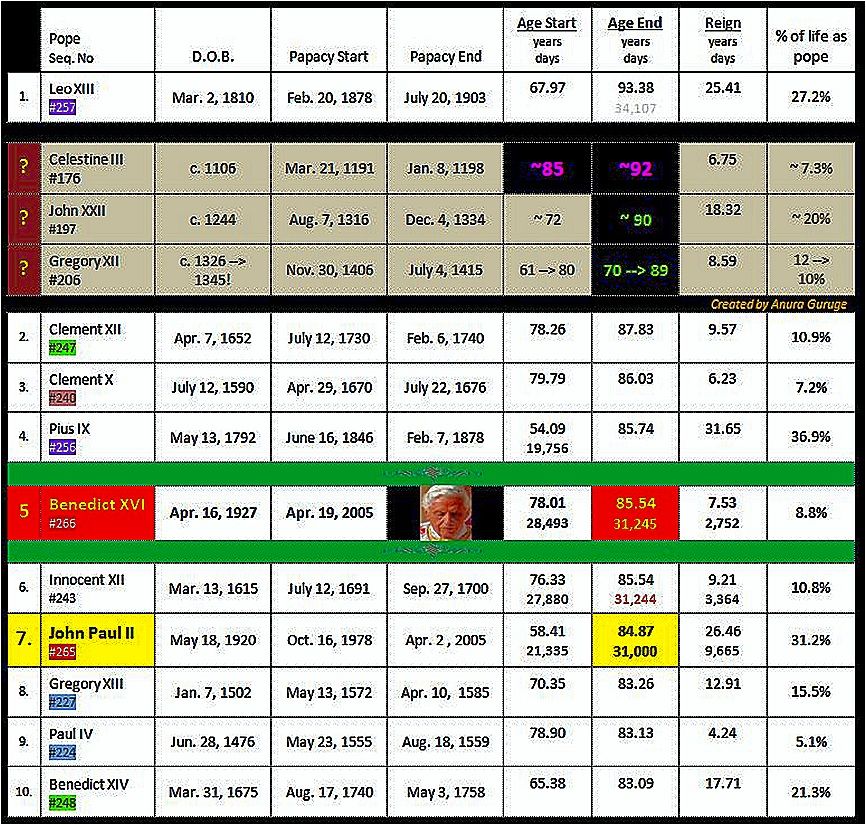
At that point, the three Popes who lived longer than he (since 1400) would be Clement X, who lived until the age of 86. He's followed by Clement XII, who lived 87 years. Leo XIII, who died at age 93, is far and away the record-holder for papal age (though two of the pre-1400 Popes included in the chart could have lived to 91 and 92, respectively).
|
| |
 01/11/2012 17:17 01/11/2012 17:17 |
|
| | | OFFLINE | | Post: 25.736
Post: 8.230 | Registrato il: 28/08/2005
Registrato il: 20/01/2009 | Administratore | Utente Master | |
|

 The Pope at the Angelus today:
The Pope at the Angelus today:
'All Saints' Day points man
towards his eternal destiny'
Adapted from

November 1, 2012
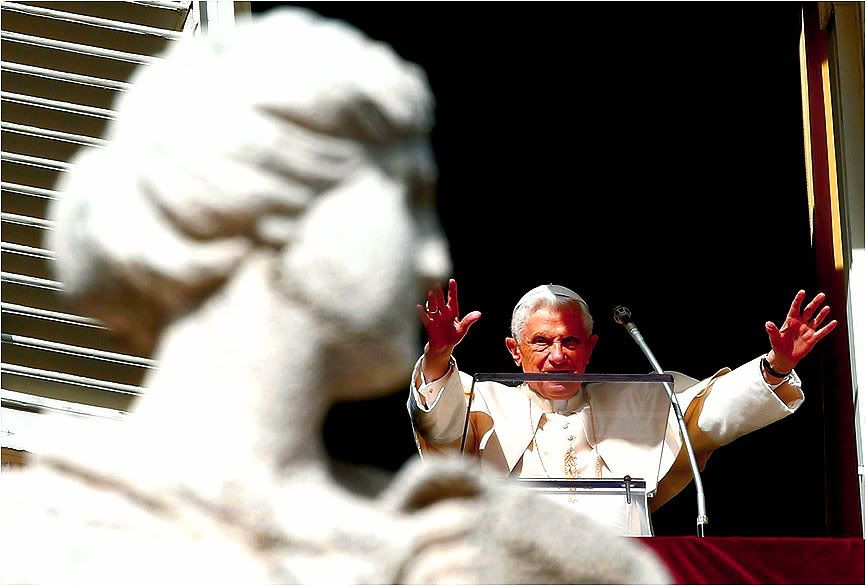
Today’s Solemnity of All Saints reminds us of our eternal destiny, where we will dwell, as Saint Thomas Aquinas says, in true and perfect light, total fulfillment, everlasting joy and gladness without end. May the intercession of all the saints lead us and our departed loved ones to our everlasting home in heaven. God bless you all!
Thus did Pope Benedict XVI synthesize his reflections on All Saints Day in his midday Angelus to pilgrims in St. Peter's Square, with an anticipation of All Souls' Day which the Church marks tomorrow.
He spoke of the significance of this liturgical feast, and how it draws our earthly gaze toward Heaven. He spoke of how the Saints, those we are familiar with and those known only to God, are where heaven and earth meet, because they had been formed and opened up by the spirit of Christ even while they were still here on earth already here on earth, in the communion of his Mystical Body, the Church.
The Feast of All Saints is keenly felt in Rome, and early today, tens of thousands of Romans made their way to Saint Peter’s square despite foreboding skies, many of them to take part in an All Saints Day mini-marathon that was to end in time for the Pope's Angelus at noon.
The police had completely shut down the area around the Vatican basilica and the long boulevard that leads up to Bernini’s colonnades, freeing Via della Conciliazione from its incessant traffic and creating an oasis of pedestrian peace. As the bells pealed from the Basilica, the runners, with a quick glance at the Pope’s study window and a sign of the cross set off.
The 10-kilometer course went through Rome;s historic centre looping from the two beating hearts of the eternal city, St Peter’s and the Campidoglio (Capitoline Hill), seat of the city government. The runners, of varying ages and ability, were all determined to cross the finish line in time for the midday prayer with their bishop, Pope Benedict XVI.
As the cannons from the Gianiculum Hill overlooking St. Peter's Square boomed at noon, the Holy Father appeared at his study window high above the square, to greet the faithful and share his reflections on this holiday.
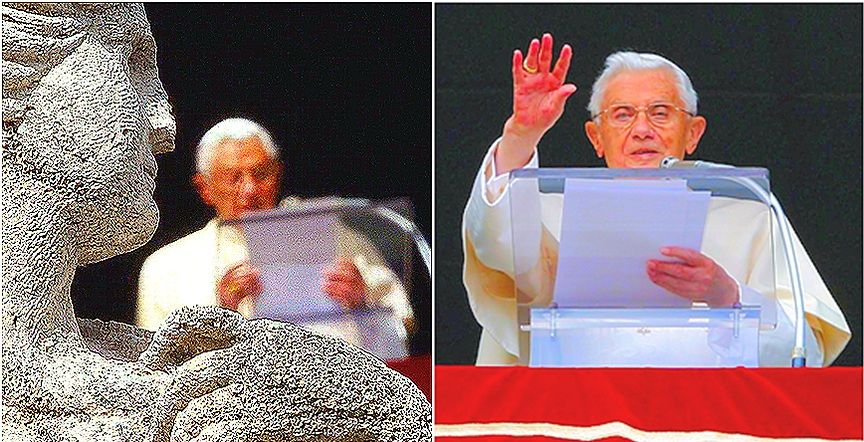
Here is Vatican Radio's translation of the Holy Father's reflections today:
Dear brothers and sisters!
Today we have the joy of meeting on the Solemnity of All Saints. This feast day helps us to reflect on the double horizon of mankind, which we symbolically express with the words "earth" and "heaven": The earth represents the journey of history, and heaven- eternity, the fullness of life in God.
And so this feast day helps us to think about the Church in its dual dimension: the Church journeying in time and the Church that celebrates the never-ending feast of the Heavenly Jerusalem. These two dimensions are united by the reality of the "communion of saints": a reality that begins here on earth and that reaches its fulfillment in heaven.
On earth, the Church is the beginning of this mystery of communion that unites all men, a mystery totally centered on Jesus Christ: it is He who introduced this new dynamic to mankind, a movement that leads towards God, and to same time towards unity, towards peace in its deepest sense.
Jesus Christ, says the Gospel of John (11:52), died "to gather into one the dispersed children of God," and this work continues in the Church which is inseparably "one", "holy" and "catholic". Being a Christian, being part of the Church, means being open to this communion, like a seed that, dying, unfolds in the ground, and sprouts upwards, toward heaven.
The Saints – those which the Church proclaims such, but also all those saints known only to God, and whom we also celebrate today - have lived this dynamic intensely. In each of them, in a very personal way, Christ was present, thanks to his Spirit which acts through the Word and the Sacraments.
In fact, being united to Christ, in the Church, does not negate one's personality, but opens it, transforms it with the power of love, and confers on it, already here on earth, an eternal dimension.
In essence, it means being conformed to the image of the Son of God (cf. Rom 8:29), fulfilling the plan of God who created man in His own image and likeness. But this insertion in Christ also opens us - as we have said - to communion with all the other members of his Mystical Body which is the Church, a communion that is perfect in "Heaven", where there is no isolation, no competition or separation .
In today's feast, we look forward to the beauty of this life fully open to the gaze of love of God and neighbor, in which we are sure to reach God and one another in God.
With this hope-filled faith, we honor all the saints, and we prepare to commemorate tomorrow the faithful departed. In the saints we see the victory of love over selfishness and death: we see that following Christ leads to life, eternal life, and gives meaning to the present, to every moment that passes, because it is filled with love and hope.
Only faith in eternal life makes us truly love history and the present, but without attachment, with the freedom of the pilgrim who loves the earth but his heart is in Heaven.
May the Virgin Mary obtain for us the grace to strongly believe in eternal life and feel ourselves in true communion with our deceased loved ones.
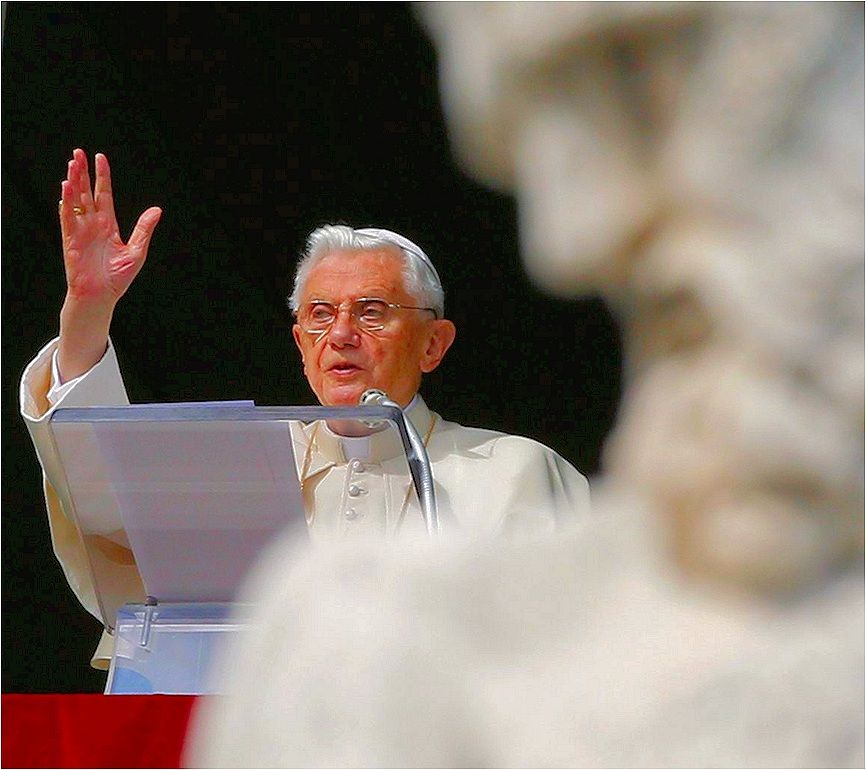 AGI's Salvatore Izzo contributes this sidelight to the Angelus today:
AGI's Salvatore Izzo contributes this sidelight to the Angelus today:
For a moment, a sunbeam striking his face blinded Pope Benedict XVI while he was reading his reflections before the Angelus prayers.
"Excuse me, my eyes are not functioning well", he said off the cuff, to explain the brief hesitation caused by the errant sunbeam.
[Modificato da TERESA BENEDETTA 01/11/2012 17:39] |
| |
 01/11/2012 19:39 01/11/2012 19:39 |
|
| | | OFFLINE | | Post: 25.737
Post: 8.232 | Registrato il: 28/08/2005
Registrato il: 20/01/2009 | Administratore | Utente Master | |
|
 I had been meaning to do this since I posted the preparatory articles on the 500th anniversary of the Sistine Chapel frescoes by Michelangelo, because it confers so much poignant resonance to any meditation on the Sistine Chapel and the unique and incomparable patrimony of all that is true, good and beautiful that man has received from God... The accompanying text of Cardinal Ratzinger's presentation of Blessed John Paul II's meditative poetry, written in 2002, increases our appreciation of the meditations, even as it heightens the poignancy immeasurably, because when Cardinal Ratzinger presented the book in March 2003, who was to know that less than two years later, John Paul II's thoughts about the Conclave to choose his successor were to apply directly to him? This the second of the three parts that make up the Triptych.
I had been meaning to do this since I posted the preparatory articles on the 500th anniversary of the Sistine Chapel frescoes by Michelangelo, because it confers so much poignant resonance to any meditation on the Sistine Chapel and the unique and incomparable patrimony of all that is true, good and beautiful that man has received from God... The accompanying text of Cardinal Ratzinger's presentation of Blessed John Paul II's meditative poetry, written in 2002, increases our appreciation of the meditations, even as it heightens the poignancy immeasurably, because when Cardinal Ratzinger presented the book in March 2003, who was to know that less than two years later, John Paul II's thoughts about the Conclave to choose his successor were to apply directly to him? This the second of the three parts that make up the Triptych.
Meditations on the Book of Genesis
at the threshold of the Sistine Chapel
from ROMAN TRIPTYCH
by Blessed John Paul II
(published 2003)
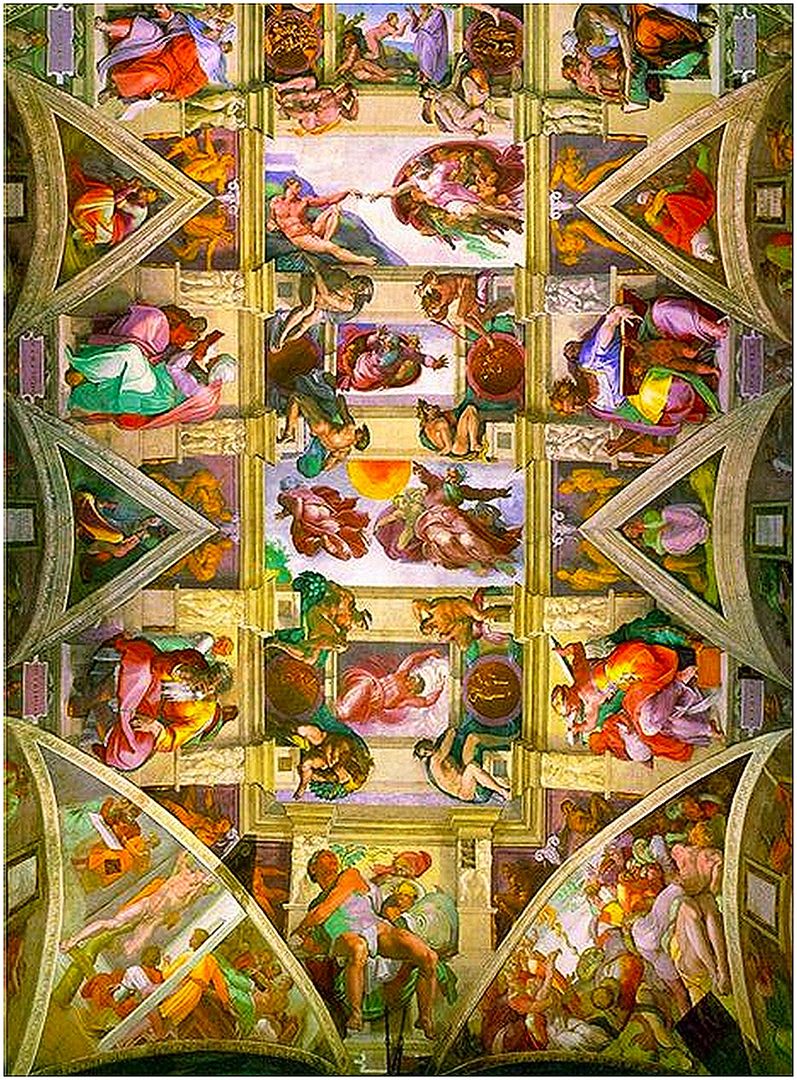
1. The first beholder
"In him we live and move and have our being",
says Paul at the Areopagus in Athens—
Who is He?
He is like an ineffable space which embraces all.
He, the Creator,
embraces everything, summoning to
existence from nothing, not only from
the beginning, but always.
Everything endures continually becoming—
"In the beginning was the Word,
and through Him all things were made".
The mystery of the beginning is born
together with the Word and is revealed through the Word.
The Word—eternal vision and utterance.
He, who was creating, saw—"saw that it was good",
his seeing different from ours.
He—the first Beholder—
saw, finding in everything some trace
of his Being, his own fullness—
He saw: Omnia nuda et aperta sunt ante oculos Eius—
Naked, transparent,
true, good and beautiful—
He saw in terms so different from ours.
Eternal vision and eternal utterance:
"In the beginning was the Word,
and through Him all things were made",
all in which we live and move and have our being —
The Word, the marvellous eternal Word,
as an invisible threshold of all
that has come into being, exists or will exist.
As if the Word were the threshold.
The threshold of the Word,
containing the invisible form of everything,
divine and eternal —
beyond this threshold everything begins to happen!
I stand at the entrance to the Sistine—
Perhaps all this could be said more simply
in the language of the "Book of Genesis".
But the Book awaits the image—
And rightly so. It was waiting for its Michelangelo.
The One who created "saw"—saw that "it was good".
"He saw", and so the Book awaited the fruit of "vision".
O all you who see, come—
I am calling you, all "beholders" in every age.
I am calling you, Michelangelo!
There is in the Vatican
a chapel that awaits the harvest of your vision!
The vision awaited the image.
From when the Word became flesh, the vision is waiting.
We are standing at the threshold of the Book.
It is the Book of the origins — Genesis.
Here, in this chapel, Michelangelo penned it,
not with words, but with the richness
of piled-up colours.
We enter in order to read it again,
going from wonder to wonder.
So then, it is here — we look and recognize
the Beginning which emerged out of nothingness,
obedient to the creative Word.
Here it speaks from these walls.
But still more powerfully the End speaks.
Yes, the judgment is even more outspoken:
the judgment, the Final one.
This is the path that all must follow—
every one of us.
2. Image and likeness
"God created man in his image,
male and female he created them
and God saw that it was very good.
Naked they were and did not feel shame".
Was it possible?
Do not ask those who are contemporary,
but ask Michelangelo
(and perhaps the contemporaries as well!?).
Ask the Sistine.
How much is said here, on these walls!
The beginning is invisible. Everything here points to it.
All this abundant visibility, released by human genius.
And the End too is invisible,
though here, traveller, your eyes are caught
by the vision of the Last Judgment.
How make the invisible visible,
how penetrate beyond the bounds of good and evil?
The Beginning and the End,
invisible, pierce us from these walls.
4. Judgment
In the Sistine the artist painted the Judgment.
The Judgment dominates the whole interior.
Here, the invisible End becomes poignant visibility.
This End is also the summit of transparency —
such is the path of all generations.
Non omnis moriar\t.
What is imperishable in me
now stands face to face with Him Who Is!
This is what fills the central wall
of the Sistine profusion of colour.
Do you remember, Adam? At the beginning
he asked you "where are you?".
And you replied: "I hid myself from You because I was naked".
"Who told you that you were naked?"….
"The woman whom you put here with me" gave me the fruit....
All those who populate the central wall of the Sistine painting
bear in themselves the heritage of that reply of yours!
Of that question and that response!
Such is the End of your path.
Epilogue
It is here, at the feet of this marvellous
Sistine profusion of colour that the Cardinals gather—
a community responsible for the legacy
of the keys of the Kingdom.
They come right here.
And once more Michelangelo wraps them in his vision.
"In Him we live and move and have our being"
Who is He?
Look, here the creating hand of the Almighty
Ancient One, turned towards Adam....
In the beginning God created....
He, the all-seeing One....
The Sistine painting will then speak with the Word of the Lord:
Tu es Petrus — as Simon, the son of Jonah, heard.
"To you I will give the keys of the Kingdom".
Those to whom the care of the legacy
of the keys has been entrusted gather here,
allowing themselves to be enfolded by the Sistine's colours,
by the vision left to us by Michelangelo—
so it was in August, and then in October
of the memorable year of the two Conclaves,
and so it will be again, when the need arises
after my death.
Michelangelo's vision must then speak to them.
"Con-clave": a joint concern
or the legacy of the keys of the Kingdom.
They will find themselves between the Beginning and the End,
between the Day of Creation and the Day of Judgment.
It is given to man once to die and after that, the judgment!
A final clarity and light.
The clarity of the events —
The clarity of consciences—
It is necessary that during the Conclave,
Michelangelo teach them— 'Do not forget:
Omnia nuda et aperta sunt ante oculos Eius.
You who see all—point to him!
He will point him out....
The complete Triptych can be read in English on www.ewtn.com/library/PAPALDOC/JP2POET.HTM
PRESENTATION OF 'ROMAN TRIPTYCH'
by Cardinal Joseph Ratzinger
March 6, 2003
At noon on Thursday, 6 March 2003, Cardinal Ratzinger presented the main themes of the new collection of the Holy Father's poems, entitled "Roman Triptych, Meditations" in the Vatican Press Hall. On the same morning in Krakow, Cardinal Francis Macharski presented them to the Polish intellectual world. Here is a translation of Cardinal Joseph Ratzinger's presentation.
First Panel: The majesty of creation
The first panel of Pope John Paul II's Roman Triptych mirrors the experience of creation, its beauty and its life. The idea of the wooded hills and the even more vivid image of the waters rushing toward the valley, the "silvery cascade, rhythmically falling from the mountain".
In this connection several sentences come to mind that were written by Karol Wojtyla in 1976 when he preached the retreat for Paul VI and the Curia. He related the case of a physicist with whom he had carried on a long discussion, and at the end of it, had said to him: "from the point of view of my science and its method I'm an atheist …" However, in a letter, the same man wrote: "Every time I find myself before the majesty of nature, of the mountains, I feel that HE exists".
One can speak of two different ways of perceiving nature! Certainly, the first panel of the triptych closes almost timidly on the threshold. The Pope does not yet speak directly of God. But he prays, as one prays to a still unknown God.
"Allow me to wet my lips in spring water, to feel its freshness, reviving freshness". With these words he seeks its source and receives directions: "if you want to find the source, you have to go up, against the current".
In the first verse of his meditation, he said: "The undulating wood slopes down"; woods and waters have shown a downward movement. His pursuit of the source, however, now obliges him to climb up, to move against the tide.
Next panels: The end and the beginning,
a vision of God
I consider that this is the key to the interpretation of the two following panels. Indeed, they guide us in the climb upward "against the current". The spiritual pilgrimage, accomplished in this text, leads towards the "Beginning". On arriving, the true surprise is that the "beginning" also reveals the "end".
Whoever knows the origin also sees the "where" and "why" of the entire movement of "being", which is becoming, and exactly in this way, also enduring: "Everything endures, continually becoming". The name of the source that the pilgrim discovers is above all the "Word", according to the first words of the Bible: "God said", which John took up and reformulated in an unmatched way in his Gospel.
"In the beginning was the Word". However, the true key word that sums up the pilgrimage in the second panel of the Triptych is not "Word", but rather vision and seeing. The Word has a face. The Word — the source — is a vision. Creation, the universe, comes from a vision. And the human person comes from a vision.
This key word therefore leads the Pope, while he meditates on Michelangelo, to the frescoes of the Sistine Chapel, that have become so dear to him.
In the images of the world, Michelangelo discerned the vision of God: he saw with the creative gaze of God, and, through this gaze, he reproduced on the wall, by means of daring frescoes, the original vision from which all reality derives.
In Michelangelo what helps us to rediscover the vision of God in the images of the world seems to be realized in an exemplary way what all of us are destined to enjoy.
The Pope says of Adam and Eve, who represent the human being in general, men and women: "So they too became sharers of that gaze". Every human person is called to "recover that gaze". The way to the source is a path that leads to becoming seers: to learn from God how to see. Then the beginning and the end appear. Then the human person becomes just.
Epilogue to the second panel:
Last Judgement and conclaves
The beginning and the end: probably for the Pope, a pilgrim journeying inwards and upwards. the link between them appeared obvious there in the Sistine Chapel, where Michelangelo presents to us the images of the beginning and the end, the vision of Creation and the impressive depiction of the Last Judgement.
The contemplation of the Last Judgement in the epilogue of the second panel is perhaps the part of the Triptych that moves the reader most. From the interior eyes of the Pope, in a fresh way, there derives once again the memory of the conclaves of August and October 1978.
Since I was also present, I know well how we were exposed to those images in the hour of the important decisions, how they challenged us and how they instilled in our souls the greatness of our responsibility.
The Pope speaks to the Cardinals of the future conclave, "after my death", and says that Michelangelo's vision will speak to them. The word "con-clave" imposes the thought of the keys, of the patrimony of the keys handed to Peter. To place these keys in the right hands: this is the immense responsibility of those days.
Here we recall the words of Jesus to the lawyers, "Woe to you lawyers! For you have taken away the key of knowledge" (Lk 11,52). Michelangelo urges us not to take away the key, but to use it to open the door so that everyone may enter.
Second panel: Creation, and dialogue in God
However, let us return to the true centre of the second panel, a look at the "origins". What do people see there?
In Michelangelo's work the Creator appears "in the likeness of a human being": the image and likeness of the human person with God is so depicted that we can deduce from it the humanity of God, that makes it possible to represent the Creator.
However, the way of looking that Christ has opened for us directs our gaze far beyond this, and shows, by contrast with the Creator, with the beginnings, who the human person really is. The Creator — the beginning — is not, as might appear in Michelangelo's painting, simply the "Almighty Ancient One".
Instead, he is "a communion of persons, a mutual exchange". If, at first, we saw God beginning with man, we now learn to see the human person starting with God: a reciprocal gift of self —t he human person is destined for this — if he manages to find the way to achieve this, he is a mirror of the essence of God, and so reveals the link between the beginning and the end.
Third Panel: Abraham and Isaac's
ascent of Mt Moria - total self-giving
The immense arch, the true vision of the Roman Triptych, is clearly revealed in the third panel, the ascent of Abraham and Isaac to Mount Moria, the mountain of the sacrifice, of self-giving without reservation.
This ascent was the last and decisive stage in Abraham's journey, that began with his departure from his own land, Ur of the Chaldeans; it is the basic stage of the ascent toward the summit, against the current, to the source that is also the goal.
In the inexhaustible dialogue between father and son, consisting of few words and of bearing together, in silence, the mystery of the words, all the questions of history, the suffering, fears and hopes are reflected.
In the end it becomes clear that this dialogue between father and son, between Abraham and Isaac, is the dialogue in God himself, the dialogue between the eternal Father and his Son, the Word, and that this eternal dialogue represents at the same time the response to our unfinished human dialogue.
Indeed at the end, Isaac is saved — the lamb is a mysterious sign of the Son who becomes the Lamb and a sacrificial victim, thus revealing to us the true face of God: the God who gives himself to us, who is entirely gift and love, to the very end (cf. Jn 13,1).
Thus in this very concrete event of history, which seems to take us so far from the great visions of creation in the first panel of the Triptych, there appears clearly the beginning and the end of all things, the link between the descent and ascent, between the source, the way and the end of the journey: we recognize God who gives himself, who is simultaneously the beginning, way, and final goal.
This God appears in creation and in history. He seeks us in our sufferings and in our questioning. He shows us what it means to be a human person: to give ourselves in love, which makes us like God. Through the journey of the Son to the mountain of sacrifice, there is revealed "the mystery hidden from the foundations of the world". The love that gives is the original mystery, and, in loving, we too can understand the message of creation and find the way.
[Modificato da TERESA BENEDETTA 02/11/2012 00:42] |
| |
 01/11/2012 22:38 01/11/2012 22:38 |
|
| | | OFFLINE | | Post: 25.738
Post: 8.233 | Registrato il: 28/08/2005
Registrato il: 20/01/2009 | Administratore | Utente Master | |
|

 The 'Credo' against false gods
The 'Credo' against false gods
The priority goal of the Year of Faith decreed by Benedict XVI -
is to bring men closer to the one true God. And to depose from their thrones
the false divinities that dominate the world.

ROME, November 2, 2012 - A naval battle taking place in the darkness of a stormy night - this was the image the Church had of herself after the first ecumenical council in history - that of Nicaea in the 4th century.
Benedict XVI often calls attention to this image to the prophets of doom today. A battle of everyone against everything, he says, that ultimately produced the Credo, the same Creed we profess today in all the Sunday masses. It was far from a disaster but a victory for the faith.
The difference between then and now is precisely in this - that the profound crisis of the Church today is a crisis of faith. Benedict XVI is so convinced of this that he thought it necessary to convoke a Year of Faith which began on October 11, and every Wednesday during the year, he has decided to begin explaining the Creed, article by article.
[It must be recalled, once again, that the articles of the Creed constituted the organizing principle for the Catechism of the Catholic Church published in 1992 under the supervision of Cardinal Joseph Ratzinger, the same organizing principle that Prof. Joseph Ratzinger had used 24 years earlier to present his first best-seller, Introduction to Christianity.]
A theologian, the Pope has turned catechist. His dream is that other catechists around the world will follow his example and make sure they return to teaching contemporary man "the central truths of the faith about God, man the Church, on all the social and cosmic realities", in short, the ABCs of the Christian faith.
Getting further into the substance of this effort, Benedict XVI has indicated many times the priority that his Pontificate gives to bring back men to God, "not just to any God", but to that God who has shown us his face in Jesus who was crucified, died and resurrected.
The decline of belief in one God in the countries with the oldest traditions of Christianity coincided precisely with the ascent of other gods in the firmament.
Even in the Church of the first centuries, those of persecutions and martyrdoms, the most acute tragedies were always those caused by 'lapsed' Christians, by those who yielded to the temptation of burning incense to the 'god emperor' in order to save their lives.
There were quite a number of them, and the purists wished to expel them as apostates. But the Church continued considering them among her children and elaborated new forms of confession, penitence and forgiveness. That very same Sacrament which is once again the one most in danger of being ignored by most Catholics whereas it continues to be so necessary.
Benedict XVI calls the new false gods by name. He did so once again in his recent extemporaneous lectio divina to the more than 200 fathers who took part in the 13th general assembly of the Bishops' Synod.
The new gods, he said, are 'the anonymous principals who enslave man today".
Such as terroristic violence 'ostensibly carried out in the name of God" but are, in fact, "committed in the name of false gods which must be unmasked".
They include drugs which "lie a ferocious beast, extends its claws on all the world and simply destroys" all who are in its grip.
Or "the lifestyles propagated by public opinion - today, this is how things are: marriage no longer means anything, chastity is no longer a virtue, and the like".
In Benedict XVI's judgment - something he reiterated recently in his preface to the two volumes of his collected writings (pre-Papacy) anthologizing what he had written about the Second Vatican Council - the strength as well as the weakness of Vatican II on its 50th anniversary lie precisely in this:
The Council had intended to revive the announcement of the Christian faith in today's world, in 'updated' ways. It has succeeded in part, but its implementation has so far failed to get into the substance of "that which is essential and constitutive of the modern age".
It is true, for instance, that the Church needed the whiplash of the Enlightenment for her to rediscover what the ancient Christians thought and practised regarding religious freedom. In this, the Pope agrees with the late Cardinal Carlo Maria Martini that the Church is truly '200 years behind the times'. [?????Where, when and how did Benedict XVI express such agreement? Besides, Martini's denunciation was of the entire institutional Church, not of any single aspect.]
But the Pope agrees even more with Cardinal Camillo Ruini, who has objected that "a distance must be kept between the Church with respect to whatever time she finds herself in, today as it was in the time of Jesus", a distance "which calls us to convert not just persons but the culture and history itself".
The Courtyard of the Gentiles organized by Cardinal Gianfranco Ravasi underscores this distance, while giving voice and a platform for dialog with the Church to the current culture which is remote from God.
For Benedict XVI, however, it is first of all most important to dethrone the false gods so that men today can rediscover the one true God.
[Modificato da TERESA BENEDETTA 02/11/2012 00:00] |
| |
 02/11/2012 09:58 02/11/2012 09:58 |
|
| | | OFFLINE | | Post: 25.741
Post: 8.236 | Registrato il: 28/08/2005
Registrato il: 20/01/2009 | Administratore | Utente Master | |
|
 Friday, Nov. 2, 30th Week in Ordinary Time
Friday, Nov. 2, 30th Week in Ordinary Time
FEAST OF ALL SOULS
Commemoration of All the Faithful Departed
'Requiem aeternam dona eis, Domine'
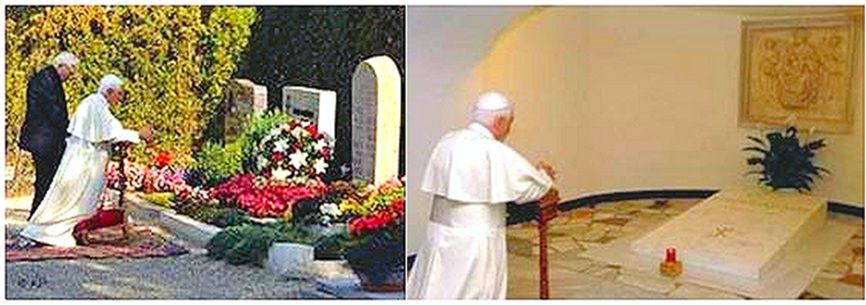 All Souls' Day commemorates the faithful departed, those who are in Purgatory and cannot immediately attain
All Souls' Day commemorates the faithful departed, those who are in Purgatory and cannot immediately attain
the beatific vision of heaven. The living can help them attain sanctification by prayer and Masses. The custom
of setting apart a special day to intercede for the faithful departed was first established by St. Odilo of Cluny
(d. 1048) at his abbey of Cluny in 998 and quickly spread through the Western Church. The Orthodox celebrate it
on several Saturdays throughout the year and associate it with Holy Saturday.
Readings for today's Mass:
www.usccb.org/bible/readings/110212.cfm
WITH THE HOLY FATHER TODAY
In the morning, he met with
- Cardinal Stanislw Dsiwisz, Archbishop of Cracow.
(He was most probably in Rome to pay homage at the tomb of Blessed John Paul II in St. Peter's Basilica.)
At 6 p.m., the Holy Father descended to the Vatican Grottoes to say private prayers at the tombs of
his predecessor Popes.
[Modificato da TERESA BENEDETTA 04/11/2012 15:42] |
| |
 02/11/2012 09:59 02/11/2012 09:59 |
|
| | | OFFLINE | | Post: 25.742
Post: 8.237 | Registrato il: 28/08/2005
Registrato il: 20/01/2009 | Administratore | Utente Master | |
|


November 2, 2012
As Cardinal Joseph Ratzinger once said so well, one major difference between Protestants and Catholics is that Catholics pray for the dead:
My view is that if Purgatory did not exist, we should have to invent it. Why? ecause few things are as immediate, as human and as widespread—at all times and in all cultures—as prayer for one"s own departed dear ones.
Calvin, the Reformer of Geneva, had a woman whipped because she was discovered praying at the grave of herson and hence was guilty, according to Calvin, of superstition. In theory, the Reformation refuses to accept Purgatory, and consequently it also rejects prayer for the departed. In fact German Lutherans at least have returned to it in practice and have found considerable theological justification for it.
Praying for one's departed loved ones is a far too immediate urge to be suppressed; it is a most beautiful manifestation of solidarity, love and assistance, reaching beyond the barrier of death. The happiness or unhappiness of a person dear to me, who has now crossed to the other shore, depends in part on whether I remember or forget him; he does not stop needing my love."
[1]Catholics are not the only ones who pray for the dead. The custom is also a Jewish one, and Catholics traditionally drew upon the following text from the Jewish Scriptures, in addition to some New Testament passages, to justify their belief:
Then Judas assembled his army and went to the city of Adulam. As the seventh day was coming on, they purified themselves according to the custom, and they kept the sabbath there.
On the next day, as by that time it had become necessary, Judas and his men went to take up the bodies of the fallen and to bring them back to lie with their kinsmen in the sepulchres of their fathers. Then under the tunic of every one of the dead they found sacred tokens of the idols of Jamnia, which the law forbids the Jews to wear. And it became clear to all that this was why these men had fallen.
So they all blessed the ways of the Lord, the righteous Judge, who reveals the things that are hidden; and they turned to prayer, beseeching that the sin which had been committed might be wholly blotted out.
And the noble Judas exhorted the people to keep themselves free from sin, for they had seen with their own eyes what had happened because of the sin of those who had fallen. He also took up a collection, man by man, to the amount of two thousand drachmas of silver, and sent it to Jerusalem to provide for a sin offering.
In doing this he acted very well and honourably, taking account of the resurrection. For if he were not expecting that those who had fallen would rise again, it would have been superfluous and foolish to pray for the dead. But if he was looking to the splendid reward that is laid up for those who fall asleep in godliness, it was a holy and pious thought. Therefore he made atonement for the dead, that they might be delivered from their sin. [2]
Besides the Jews, many ancient peoples also prayed for the deceased. Some societies, such as that of ancient Egypt, were actually "funereal" and built around the practice.[3]
The urge to do so is deep in the human spirit which rebels against the concept of annihilation after death. Although there is some evidence for a Christian liturgical feast akin to our All Souls Day as early as the fourth century, the Church was slow to introduce such a festival because of the persistence, in Europe, of more ancient pagan rituals for the dead.
In fact, the Protestant reaction to praying for the dead may be based more on these survivals and a deformed piety from pre-Christian times than on the true Catholic doctrine as expressed by either the Western or the Eastern Church. The doctrine of purgatory, rightly understood as praying for the dead, should never give offense to anyone who professes faith in Christ
.
When we discuss the Feast of All Souls, we look at a liturgical commemoration which pre-dated doctrinal formulation itself, since the Church often clarifies only that which is being undermined or threatened.
The first clear documentation for this celebration comes from Isidore of Seville (d. 636; the last of the great Western Church Fathers) [and a Doctor of the Church] whose monastic rule includes a liturgy for all the dead on the day after Pentecost. [4] St. Odilo (962-1049 AD) was the abbot of Cluny in France who set the date for the liturgical commemoration of the departed faithful on November 2.
Before that, other dates had been seen around the Christian world, and the Armenians still use Easter Monday for this purpose. He issued a decree that all the monasteries of the congregation of Cluny were annually to keep this feast.
On November 1 the bell was to be tolled and afterward the Office of the Dead was to be recited in common, and on the next day all the priests would celebrate Mass for the repose of the souls in purgatory. The observance of the Benedictines of Cluny was soon adopted by other Benedictines and by the Carthusians who were reformed Benedictines.
Pope Sylvester in 1003 AD approved and recommended the practice. Eventually the parish clergy introduced this liturgical observance, and from the eleventh to the fourteenth century it spread in France, Germany, England, and Spain.
Finally, in the fourteenth century, Rome placed the day of the commemoration of all the faithful departed in the official books of the Western or Latin Church. November 2 was chosen in order that the memory of all the holy spirits, both of the saints in heaven and of the souls in purgatory, should be celebrated in two successive days. In this way the Catholic belief in the Communion of Saints would be expressed.
Since for centuries the Feast of All the Saints had already been celebrated on November first, the memory of the departed souls in purgatory was placed on the following day. All Saints Day goes back to the fourth century, but was finally fixed on November 1 by Pope Gregory IV in 835 AD. The two feasts bind the saints-to-be with the almost-saints and the already-saints before the resurrection from the dead.
Incidentally, the practice of priests celebrating three Masses on this day is of somewhat recent origin, and dates back only to ca. 1500 AD with the Dominicans of Valencia. Pope Benedict XIV extended it to the whole of Spain, Portugal, and Latin America in 1748 AD. Pope Benedict XV in 1915 AD granted the "three Masses privilege" to the universal Church. [5]
On All Souls Day, can we pray for those in limbo? The notion of limbo is not ancient in the Church, and was a theological extrapolation to provide explanation for cases not included in the heaven-purgatory-hell triad. Cardinal Ratzinger was in favor of its being set aside, and it does not appear as a thesis to be taught in the new Universal Catechism of the Catholic Church. [6]
The doctrine of Purgatory, upon which the liturgy of All Souls rests, is formulated in canons promulgated by the Councils of Florence (1439 AD) and Trent (1545-1563 AD). The truth of the doctrine existed before its clarification, of course, and only historical necessities motivated both Florence and Trent to pronounce when they did. Acceptance of this doctrine still remains a required belief of Catholic faith.
What about "indulgences"? Indulgences from the treasury of grace in the Church are applied to the departed on All Souls Day, as well as on other days, according to the norms of ecclesiastical law. The faithful make use of their intercessory role in prayer to ask the Lord"s mercy upon those who have died. Essentially, the practice urges the faithful to take responsibility. This is the opinion of Michael Morrissey:
Against the common juridical and commercial view, the teaching essentially attempts to induce the faithful to show responsibility toward the dead and the communion of saints. Since the Church has taught that death is not the end of life, then neither is it the end of our relationship with loved ones who have died, who along with the saints make up the Body of Christ in the "Church Triumphant."
The diminishing theological interest in indulgences today is due to an increased emphasis on the sacraments, the prayer life of Catholics, and an active engagement in the world as constitutive of the spiritual life. More soberly, perhaps, it is due to an individualistic attitude endemic in modern culture that makes it harder to feel responsibility for, let alone solidarity with, dead relatives and friends. [7]
As with everything Christian, then, All Souls Day has to do with the mystery of charity, that divine love overcomes everything, even death. Bonds of love uniting us creatures, living and dead, and the Lord who is resurrected, are celebrated both on All Saints Day and on All Souls Day each year.
All who have been baptized into Christ and have chosen him will continue to live in Him. The grave does not impede progress toward a closer union with Him. It is only this degree of closeness to Him which we consider when we celebrate All Saints one day, and All Souls the next.
Purgatory is a great blessing because it shows those who love God how they failed in love, and heals their ensuing shame. Most of us have neither fulfilled the commandments nor failed to fulfill them. Our very mediocrity shames us. Purgatory fills in the void. We learn finally what to fulfill all of them means. Most of us neither hate nor fail completely in love. Purgatory teaches us what radical love means, when God remakes our failure to love in this world into the perfection of love in the next.
As the sacraments on earth provide us with a process of transformation into Christ, so Purgatory continues that process until the likeness to Him is completed. It is all grace. Actively praying for the dead is that "holy mitzvah" or act of charity on our part which hastens that process. The Church encourages it and does it with special consciousness and in unison on All Souls Day, even though it is always and everywhere salutary to pray for the dead.
ENDNOTES:
[1] See Joseph Cardinal Ratzinger, The Ratzinger Report: An Exclusive Interview on the State of the Church, with Vittorio Messori (San Francisco: Ignatius Press, 1985) 146-147. Michael P. Morrissey says on the point: "The Protestant Reformers rejected the doctrine of purgatory, based on the teaching that salvation is by faith through grace alone, unaffected by intercessory prayers for the dead." See his "Afterlife" in The Dictionary of Catholic Spirituality, ed. Michael Downey (Collegeville: Michael Glazier/Liturgical Press, 1993) 28.
[2] Maccabees 12:38-46. From The Holy Bible, Revised Standard Version, Containing the Old and New Testaments. Catholic Edition. (London: The Catholic Truth Society, 1966) 988-989. Neil J. McEleney, CSP, adds: "These verses contain clear reference to belief in the resurrection of the just...a belief which the author attributes to Judas ...although Judas may have wanted simply to ward off punishment from the living, lest they be found guilty by association with the fallen sinners.... The author believes that those who died piously will rise again...and who can die more piously than in a battle for God"s law? ...Thus, he says, Judas prayed that these men might be delivered from their sin, for which God was angry with them a little while.... The author, then, does not share the view expressed in 1 Enoch 22:12-13 that sinned- against sinners are kept in a division of Sheol from which they do not rise, although they are free of the suffering inflicted on other sinners. Instead, he sees Judas"s action as evidence that those who die piously can be delivered from unexpiated sins that impede their attainment of a joyful resurrection. This doctrine, thus vaguely formulated, contains the essence of what would become (with further precisions) the Christian theologian's teaching on purgatory." See The New Jerome Biblical Commentary, ed. Raymond E. Brown, SS, etal., art. 26, "1-2 Maccabees" (Englewood Cliffs, N.J.: Prentice Hall, 1990) 446. Gehinnom in Jewish writings is more appropriately understood as a purgatory than a final destination of damnation.
[3] Spanish-speaking Catholics today popularly refer to All Souls Day as "El Día de los Muertos", a relic of the past when the pre- Christian Indians had a "Day of the Dead"; liturgically, the day is referred to as "El Día de las Animas". Germans call their Sunday of the Dead "Totensonntag". The French Jesuit missionaries in New France in the seventeenth century easily explained All Souls Day by comparing it to the the local Indian "Day of the Dead". The Jesuit Relations are replete with examples of how conscious were the people of their duties toward their dead. Ancestor worship was also well known in China and elsewhere in Asia, and missionaries there in times gone by perhaps had it easier explaining All Souls Day to them, and Christianizing the concept, than they would have to us in the Western world as the twentieth century draws to a close.
[4] See Michael Witczak, "The Feast of All Souls", in The Dictionary of Sacramental Worship, ed. Peter Fink, SJ, (Collegeville: Michael Glazier/Liturgical Press, 1990) 42.
[5] "Three Masses were formerly allowed to be celebrated by each priest, but one intention was stipulated for all the Poor Souls and another for the Pope"s intention. This permission was granted by Benedict XV during the World War of 1914-1918 because of the great slaughter of that war, and because, since the time of the Reformation and the confiscation of church property, obligations for anniversary Masses which had come as gifts and legacies were almost impossible to continue in the intended manner. Some canonists believe Canon 905 of the New Code has abolished this practice. However, the Sacramentary, printed prior to the Code, provides three separate Masses for this date." See Jovian P. Lang, OFM, Dictionary of the Liturgy (New York: Catholic Book Publishing Company, 1989) 21. Also see Francis X. Weiser, The Holyday Book (New York: Harcourt, Brace and Company, 1956) 121-136.
[6] Ratzinger stated: "Limbo was never a defined truth of faith. Personally—and here I am speaking more as a theologian and not as Prefect of the Congregation—I would abandon it since it was only a theological hypothesis. It formed part of a secondary thesis in support of a truth which is absolutely of first significance for faith, namely, the importance of baptism. To put it in the words of Jesus to Nicodemus: "Truly, truly, I say to you, unless one is born of water and the Spirit, he cannot enter the Kingdom of God" (John 3:5). One should not hesitate to give up the idea of "limbo" if need be (and it is worth noting that the very theologians who proposed "limbo" also said that parents could spare the child limbo by desiring its baptism and through prayer); but the concern behind it must not be surrendered. Baptism has never been a side issue for faith; it is not now, nor will it ever be." See Ratzinger, The Ratzinger Report, 147-148.
[7] Morrissey, "Afterlife" in The Dictionary of Catholic Spirituality, 28-29.
Friday today... so I will be gone the rest of the day.
[Modificato da TERESA BENEDETTA 02/11/2012 10:26] |
| |
 03/11/2012 14:01 03/11/2012 14:01 |
|
| | | OFFLINE | | Post: 25.743
Post: 8.238 | Registrato il: 28/08/2005
Registrato il: 20/01/2009 | Administratore | Utente Master | |
|
 Saturday, Nov. 3, 30th Week in Ordinary Time
Saturday, Nov. 3, 30th Week in Ordinary Time
 ST. MARTIN DE PORRES (Peru, 1579-1639), Barber/Medical Aide, Dominican Friar, Miracle Worker
ST. MARTIN DE PORRES (Peru, 1579-1639), Barber/Medical Aide, Dominican Friar, Miracle Worker
Illegitimate son of a Spanish nobleman and a freed black slave, and rejected by his father because he inherited his mother's color, Martin was raised in poverty. At 12, he was apprenticed to a barber-surgeon and learned first aid and how to prepare and administer medications. After a few years in this work, he applied to be a Dominican lay brother. For nine years, he was such a model of prayer and penance, charity and humility, that the order asked him to profess fully as a friar. He belonged to that special breed of friar saints who worked menial jobs and doubled as beggar, fund-raiser and spiritual counselor to all. In addition, he continued his medical apostolate actively, founded the first orphanage in the New World, and took care of slaves just arrived from Africa. On normal days, he fed as many as 120 persons a day out of the alms he collected. He was blessed with extraordinary graces, such as ecstasies and visions, levitation, bilocation, ability to communicate with animals, and miracle cures even in his lifetime. Though he never left Lima, there were tales of beneficiaries seeing him and being healed in places like Algeria, Japan and China. He was a spiritual adviser to many, including the future St. Rose of Lima, the viceroy of Peru and the archbishop of Lima. When he died, all Lima turned out to pay homage to him, with mourners snipping off a piece of his habit that his burial clothes had to be replaced three times. Miracles proliferated after his death, and when his body was exhumed 25 years later, it was found incorrupt and exuding the odor of sanctity. He was beatified in 1837 and canonized in 1962. He is the patron saint of persons with mixed blood, of barbers, and of public health.
Readings for today's Mass:
www.usccb.org/bible/readings/110312.cfm
AT THE VATICAN TODAY
The Holy Father presided this morning at a Mass at the Altar of Peter's Chair in St. Peter's Basilica
for the 10 cardinals and 143 bishops around the world who died in the past 12 months. Homily.
|
| |
 03/11/2012 14:37 03/11/2012 14:37 |
|
| | | OFFLINE | | Post: 25.744
Post: 8.239 | Registrato il: 28/08/2005
Registrato il: 20/01/2009 | Administratore | Utente Master | |
|


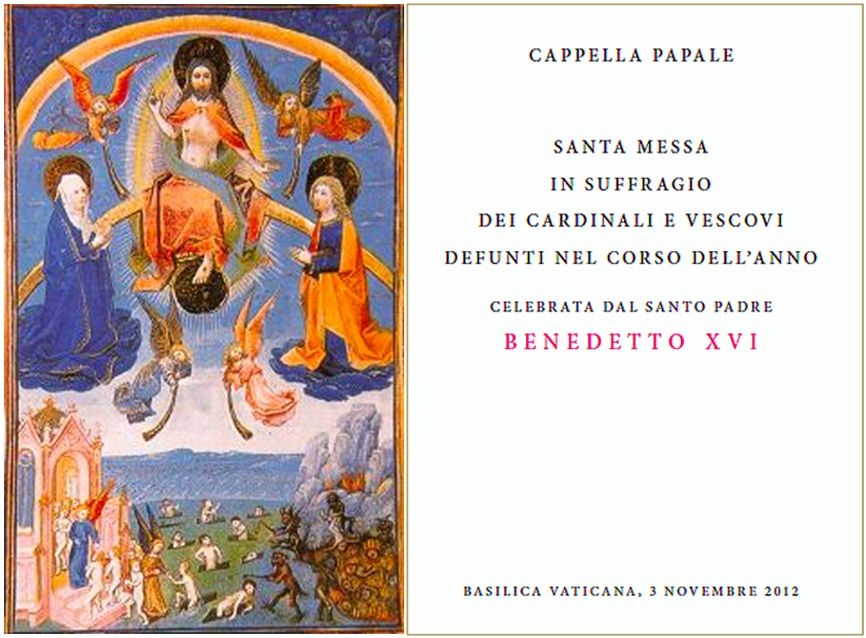 Libretto cover: 'The Last Judgment', miniature from the Book of Hours of Isabel the Catholic (Queen of Spain, 1451-1504), 15th century, Biblioteca Real del Escorial, National Patrimony of Spain.
Pope offers Mass for cardinals
Libretto cover: 'The Last Judgment', miniature from the Book of Hours of Isabel the Catholic (Queen of Spain, 1451-1504), 15th century, Biblioteca Real del Escorial, National Patrimony of Spain.
Pope offers Mass for cardinals
and prelates who passed away
in the past 12 months

Nov. 3, 2012
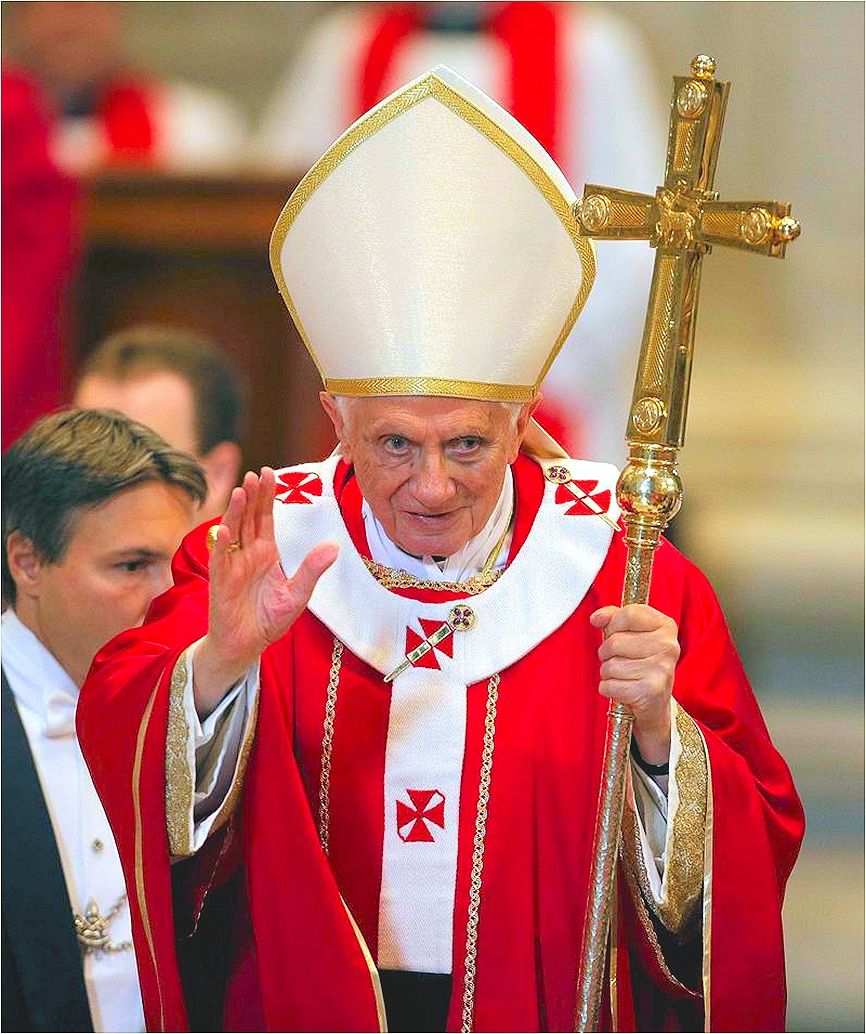
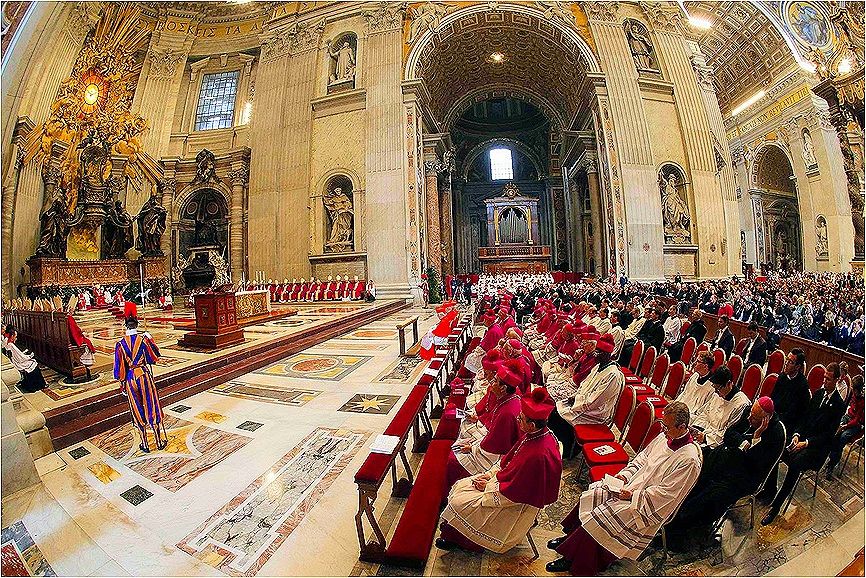
“How do we as Christians respond to the question of death?” was the problem posed by Pope Benedict XVI Saturday morning as together with cardinals and bishops present in Rome, he celebrated Mass in suffrage for the 8 cardinals and 143 bishops who died in the course of the past year.
At the Altar of the Chair in St Peter’s basilica, Pope Benedict spoke to the assembly of orelationship with death and the dead, evoking the atmosphere of the recent liturgical feasts of All Saints and All Souls, during which faithful traditionally visit the gravesides of loved ones.
Cemeteries, he said speak of how our deceased lived, they are “sorts of assembly points, in which the living meet their dead and …rediscover the bonds of communion that death could not break”.
Benedict XVI then evoked the Roman catacombs, describing them as “peculiar cemeteries” where descending to their corridors, “it is as if we cross an immaterial threshold and enter into communication with those custodied within, their past, made of joys and sorrows, losses and hopes. This occurs because death is still relevant to man today just as then, and even if many things of the past have become alien to us, death is still the same”.
Yet “faced with this reality, human beings of all ages look for a glimmer of light that brings hope that still speaks of life”. As Christians, he said, “we respond with faith in God, based on Christ’s victory over death on the Cross and His Resurrection that opened death to the promise of Eternal Life”. “This is life at its fullness: life in God, a life which we can now only catch glimpses of, like blue sky through a fog”.
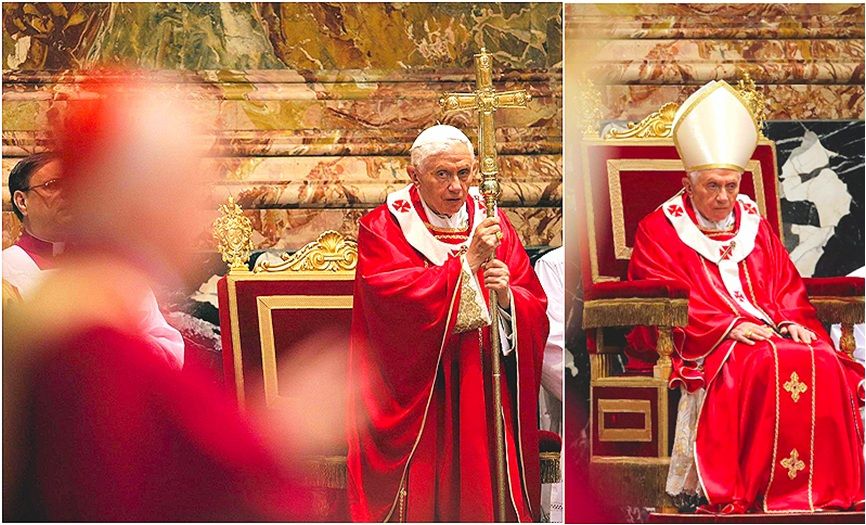
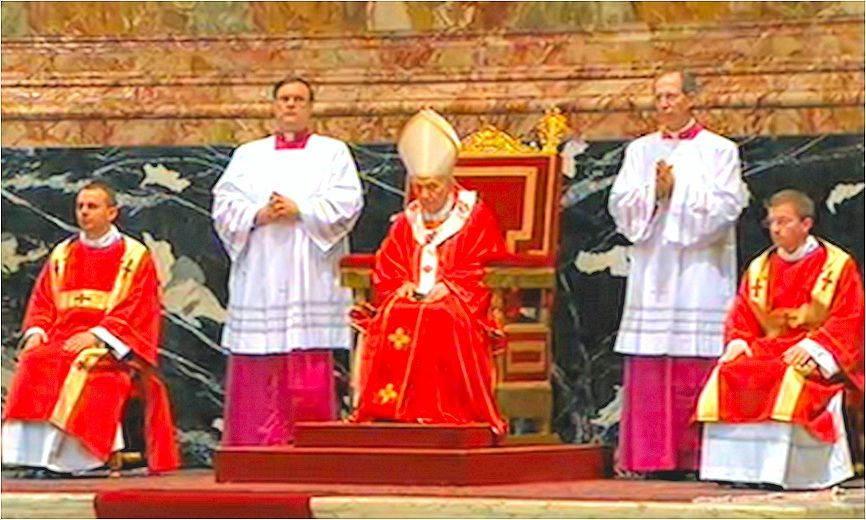
Here is a translation of the Holy Fahter's homily:
Venerated Brothers,
Dear brothers and sisters:
The atmosphere of the communion of saints and the commemoration of the faithful departed that the liturgy of the past two days ahs made us live so intensely, remains vivid in our hearts.
In particular, the visit to our cemeteries has allowed us to renew our ties with the dear persons who have left us. Death paradoxically preserves that which life could not hold back.
How our beloved ones lived, what they loved, feared and hoped for, what they rejected - all this we discover, in fact, in a singular way, from their tombs which have remained almost like a mirror of their existence, their world. They interpellate us and lead us to renew a dialog which death had placed in crisis.
And so, the places where they are buried constitute almost a sort of assembly, in which the living meet their own dead ones and renew the ties of communion with them that death cannot interrupt.
Here in Rome, in those peculiar cemeteries that the catacombs are, we can observe as in no other place, our profound link to early Christianity which we feel so near to us. When we pass through the corridors of the Roman catacombs - as through the cemetery alleys in our cities and towns - it is as if we were crossing an immaterial threshold to enter into communication with those who guard therein their past, of joys and sorriws, of defeats and hopes.
This happens because death concerns the man of today exactly as it did man in the past. And even if so many things from the past have become strange and extraneous, death remains the same.
In the face of this reality, the human being in every age has sought a glimmer of light that makes him hope, that still speaks of life, and our visit to the tombs expresses this desire.
How do we Christians respond to the question of death? We respond with faith in God, with an outlook of solid hope that is based on the Death and Resurrection of Jesus Christ. In which death opens to life, eternal life, which is not an infinite copy of the present time, but something completely new.
Faith tells us that the true immortality to which we aspire is not an idea, a concept, but a relation of full communion with the living God. It is being in his hands, in his love, and to become in him one with all the brothers and sisters he had created and redeemed - with all of creation.
Thus our hope rests on the love of God that shines forth from the Cross of Christ and which makes the words of Jesus to the good thief resound in our hearts: 'This day you will be with me in Paradise" (Lk 23,43).
This is life that has achieved fulfillment - a life in God, a life which we can now only glimpse as one sees a bit of blue sky through a fog.
In this climate of faith and pryer, dear friends, we are gathered around the altar to offer the Eucharistic Sacrifice in suffrage for the cardinals, archbishops and bishops who in the past year ended their earthly existence.
In particular, we remember our lamented brother Cardinals John Patrick
Foley, Anthony Bevilacqua, José Sánchez, Ignace Moussa Daoud, Luis Aponte Martínez, Rodolfo Quezada Toruño, Eugênio de Araújo Sales, Paul Shan Kuo-hsi, Carlo Maria Martini, and Fortunato Baldelli.
We extend our affectionate remembrance to all the departed archbishops and bishops, asking the Lord, who is merciful and just (cfr Ps 114), to grant them the eternal prize promised to faithful servants of the Gospel.
Thinking back on the witness of these venerated brothers of ours, we can recognize in them those disciples who are 'meek', 'merciful', 'pure of heart', about whom the Gospel passage (Mt 5,1-12): friends of the Lord who, trusting in his promise, kept the joy of faith even in difficulties and persecutions, and who now inhabit for always the house of the Father and enjoy the reward of Heaven, full of happiness and grace.
The Pastors whom we remember today, in fact, served the Church with faithfulness and love, sometimes facing onerous trials, in order to assure theur flock of the attention and care for those who had been entrusted to thir hands.
In the variety of their respective gifts and tasks, they have given an example of diligent vigilance, of wisdom and zealous dedication to the Kingdom of God, offering their valuable copntribution to the post-conciliar season, a time of renewal for the whole Church.
The eucharistic Mass that we are attending, first as faithful, and daily, as ministers, anticipates in the most eloquent way what the Lord promised in the Sermon on the Mount: possession of the Kingdom of the heavens, taking part in the banquet of the heavenly Jerusalem. Let us pray that this may be fulfilled for everyone.
Our prayer is nourished by the firm hope that "does not disappoint" (Rm 5,5) because it is guaranteed by Christ who wished to live in the flesh the experience of death in order to triumph over it with the miraculous event of the Resurrection.
“Why do you seek the living one among the dead? He is not here, but he has been raised" (Lk 24,5-6). This announcement by the angels on the morning of Easter near the empty tomb has reached us through the centuries, and gives us, as it does in this liturgical assembly, the essential reason for our hope.
In fact, St. Paul reminds us, "If, then, we have died with Christ," alluding to what happens in Baptism, "we believe that we shall also live with him" (Rm 6,8), It is the same Holy Spirit, through whom the love of God has been poured into our hearts, who makes sure that our hope may not be in vain(cf Rm 5,5),.
God the Father, rich in mercy, gave his son to die for us when we were all sinners - how can he not give us salvation now that we have been made just through his blood (cfr Rm 5,6-11),?
Our justice is based on faith in Christ. He is the Just One, pre-announced in all of Scripture. It is thanks to his Paschal mystery that, having crossed the threshold of death, our eyes will be able see God and contemplate his face (cfr Job 19,27a).
Alongside the singular human existence of the Son of God was that of his Most Blessed Mother, who, alone among all creatures, we venerate as Immaculate and full of grace. Our brother Cardinals and Bishops, whom we remember today, were especially loved by the Virgin Mary and returned her love with filial devotion.
Today, let us entrrust their souls to her maternal intercession so that she may introduce them to the eternal Kingdom of the Father, surrounded by all the faithful for whom they gave their lives. With her loving attention, may Mary watch over them who now sleep in peace while awaiting blessed resurrection.
We elevate our prayers for them to God, sustained by the hope of finding ourselves one day reunited for always in Paradise. Amen.
[Modificato da TERESA BENEDETTA 04/11/2012 16:42] |
| |
 04/11/2012 14:02 04/11/2012 14:02 |
|
| | | OFFLINE | | Post: 25.745
Post: 8.240 | Registrato il: 28/08/2005
Registrato il: 20/01/2009 | Administratore | Utente Master | |
|

 Another Mass was said earlier yesterday at St. Peter's Basilica. also at the Altar of the Chair - one that many had hoped would have been said by Benedict XVI himself...
Traditionalist pilgrims thank the Pope
Another Mass was said earlier yesterday at St. Peter's Basilica. also at the Altar of the Chair - one that many had hoped would have been said by Benedict XVI himself...
Traditionalist pilgrims thank the Pope
in a Mass celebrated by Cardinal Canizares
by Salvatore Izzo


VATICAN CITY, Nov. 4 (Translated from AGI) - To thank Benedict XVI who, in 1977, liberalized the use of the pre-Vatican II Mass said in Latin, which was replaced in 1069 by Paul VI's Novus Ordo using the congregation's language instead, a procession of traditionalist faithful came down through Via della Conciliazione yesterday towards St. Peter's Basilica where Cardinal Antonio Canizares Llovera, Prefect of the Congregation for Divine Worship, presided at what is now called the Extraordinary Form of the Mass.
It was the conclusion of a pilgrimage they named 'Una cum papa nostro' (One with our Father), organized by numerous traditionalist organisms and associations who have been attending the Extraordinary Form of the Mass as decreed by the Holy Father's motu proprio in July 2007.
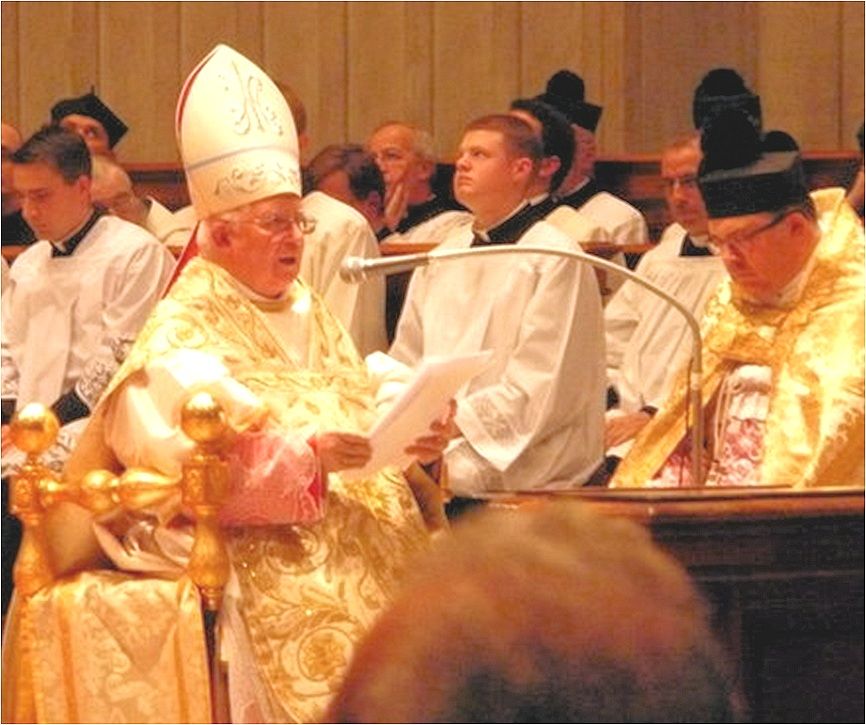
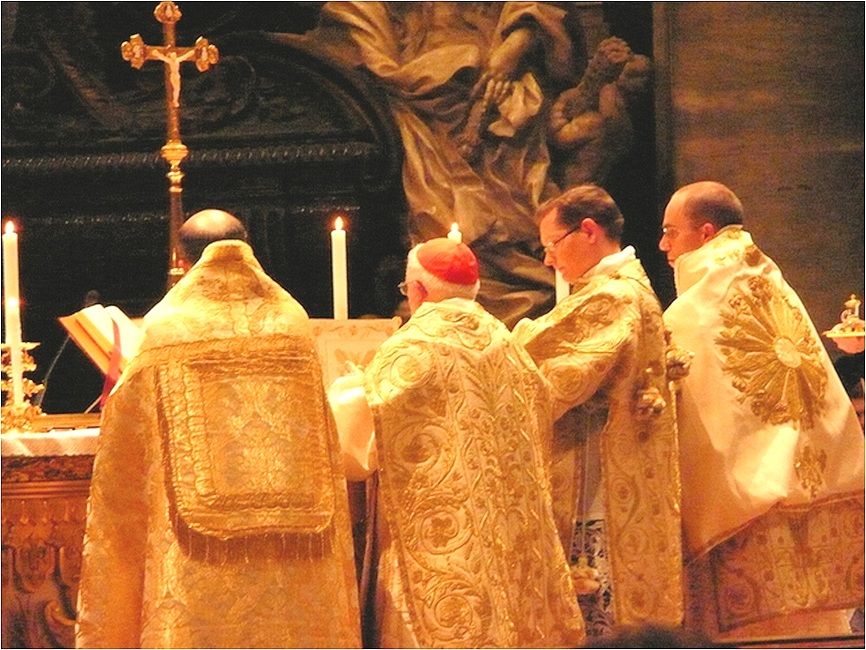
"I gladly accepted to celebrate Mass today for the pilgrims who have come to than the Pope for the gift of the motu proprio", said Cardinal Canizares to Vatican Insider, which also announced previously that the Mass would also be attended by Archbishop Augustine de Noia, recently named vice-president of the Ponitifical Commission Ecclesia Dei under the Congregation for the Doctrine of the Faith. Ecclesia Dei was formed in 1988 by John Paul II to act as a liaison with traditionalist groups protesting the replacement of the traditional Mass, including the Lefebvrian FSSPX.
The cardinal says he believes that the event was "a way to make it understood that it is now just as normal to use the Extraordinary Form of the one Roman rite, that there are two forms of the rite, but it is the same rite, and therefore, to celebrate it is normal".
Yesterday's observance served to place the spotlight once again on the pre-Conciliar Mass that was virtually abandoned for almost half a century by the universal Church even if it was never declared invalid or abrogated by the adoption of the Novus Ordo.
"The motu proprio issued five years ago," he said, "revalidated the liturgy which was celebrated according to the Missal of Blessed John XXIII (latest revision of the Tridentine Mass that was standardized by St. Pius V after the Council of Trent in the 16th century), underscoring the continuity of tradition in the Roman rite. Acknowledging the pre-Conciliar liturgy means to understand that reform does not necessarily reject what was previously in use".
The former Primate of Spain and Archbishop of Toledo said "I have celebrated the Extraordinary Form several times before now, and I do so gladly today".
"The Congregation of which the Pope called me to be Prefect obviously has nothing against the Extraordinary Form even if the main task of our dicastery is to help deepen understanding of the liturgical reforms carried out under Vatican II's constitution on the liturgy, Sacrosanctum concilium," he went on.
"One must add, however, that even the Extraordinary Form must be illuminated by that constitution which, in its first ten paragraphs, explains the spirit of liturgy which is valid for all rites".
The cardinal said he was glad that five years after the motu proprio, "little by little, but more and more, it is being understood how liturgy is fundamental in the Church, and that we must renew the sense of mystery and sacredness in our liturgical celebrations".
After this initial period of the universal revival of the traditional Mass, he said "we can better understand that it was not about the faithful who lived in nostalgia for the Latin Mass, but it is for everyone to deepen their sense of the liturgy".
"We are all 'the Church', we all live the same communion, and Pope Benedict XVI said it best on the first anniversary of Summorum Pontificum when he said 'no one can be considered one too many in the Church'.
More than a thousand pilgrims heard the Mass at the Altar of the Chair in St. Peter's Basilica, where Cardinal Canizares said the Mass facing the altar at the apse of the Basilica, placed beneath the amber glass window by Bernini depicting the Holy Spirit as a white dove.
The Altar itself contains what is believed to have been a wooden chair used by St. Peter, clad in bronze by Bernini, and symbolizing the legacy of the keys and the Petrine primacy.
The cardinal wore traditional vestments, from the Roman chasuble to the matching maniple and gloves.
[Two cardinals had previously celebrated the EF Mass at St. Peter's Basilica after Sumorum Pontificum, but both at side altars - Cardinal Raymod Burke. Prefect of the Supremed Tribunal of the Apostolic Segnatura, and Cardinal Walter Brandmueller, emeritus president of the Pontifical Commission on Historical Sciences.]
[Modificato da TERESA BENEDETTA 04/11/2012 16:38] |
| |
 04/11/2012 15:33 04/11/2012 15:33 |
|
| | | OFFLINE | | Post: 25.746
Post: 8.241 | Registrato il: 28/08/2005
Registrato il: 20/01/2009 | Administratore | Utente Master | |
|
 Nov. 4, 31st Sunday in Ordinary Time
Nov. 4, 31st Sunday in Ordinary Time
 Center painting: San Carlo (left) and St. Francis (right), in adoration at the Manger.
ST. CARLO BORROMEO (Italy 1538-1584). Church Administrator, Cardinal, Papal Secretary of State, Reformer, Bishop of Milan
Center painting: San Carlo (left) and St. Francis (right), in adoration at the Manger.
ST. CARLO BORROMEO (Italy 1538-1584). Church Administrator, Cardinal, Papal Secretary of State, Reformer, Bishop of Milan
A Medici on his mother's side, he was born in Arona, northwest Italy. and was a precocious learner. When his uncle, Cardinal Angelo de Medici, became Pius IV in 1559, he made Carlo a cardinal deacon and administrator of the Church of Milan even if he was a layman and still a student. By age 22, he was Vatican secretary of state in charge of the Papal States. He rejected his family's desire for him to marry and carry on the lineage when his older brother died. Instead, he became a priest and at age 25, was consecrated Archbishop of Milan. Meanwhile, however, the Council of Trent was underway and this kept him from taking up his post in Milan. He worked tirelessly behind the scenes and facilitated the Council's final deliberations. He also had a large part in drawing up the Tridentine Catechism, and in the reform of teh Roman Missal and Breviary. When he finally took up his duties in Milan, he devoted himself to the reform of every phase of Catholic life among the clergy and the laity. He enjoined the clergy that unless they gave the Christian example and renewed their apostolic spirit, they could not succeed with their flocks. He set the example for poverty and penitence. In the famine of 1576, he borrowed large sums of money to be able to feed up to 70,000 people a day, and stayed in the city to tend to the victims, while civilian authorities fled. He was greatly esteemed by his brother cardinals, and his counsel was sought by the Catholic sovereigns of Europ: Henry III of France, Philip II of Spain, and Mary, Queen of Scots. His thought lives on in his letters and homilies, which are among the most quoted even today. The heavy burdens of his office took a toll on his health and he died at the young age of 46. In Milan, popular devotion to him as a saint arose quickly and continued to grow. The Milanese celebrated his anniversary as though he were already canonized. Supporters initiated the process for his canonization in Milan, Pavia, Bologna and other places. He was beatified in 1602 and canonized in 1610. His remains are enshrined in a glass urn in a crypt of the Cathedral of Milan. Im 2010, the Archdiocese of Milan marked the fourth centenary of his canonization.
Readings for today's Mass:
www.usccb.org/bible/readings/110412.cfm
WITH THE HOLY FATHER TODAY
Sunday Angelus - The Holy Father reflected on today's Gospel reading from St. Mark on 'the greatest commandment of all' -
love of God and, inseparable from it, love of our fellowmen.
|
| |
|
|
|
|